#so as a really simplified example i could be presenting and acting exactly the same way with two different people
Explore tagged Tumblr posts
Text
someone should study how gender performance gets surveilled and disciplined in gay dating btw
#what if it were me..........#genuinely i find it so interesting that as gay and trans people we're often aware of sex and romance#as areas where heterosexuality and gender roles are policed and maintained#but there can be this willful ignorance that these reinforcements are happening in different directions in our own contexts#when i was going on a lot of first dates i felt like people often had a sort of rorschach test level of variability in how they interpreted#my gender performance and presentation#usually in relation to however they conceived of their own gender and attractions#so as a really simplified example i could be presenting and acting exactly the same way with two different people#and one would call me butch and one would call me femme#and i don't think i'm either but it was really fascinating trying to figure out from context clues where people's heads were at#and when i got into relationships with people they often tried to steer me towards gender performance that reinforced their read#or they would just stubbornly interpret in that same vein regardless of what i was actually saying or doing#and it was rarely in a 'are you the boy or the girl' way which is i think the only way i see it get talked about#like i've definitely gone out with people who wanted to read my gender as being similar to theirs to reinforce their own sense of self#and of course forms of gender surveillance and policing are modulated by attraction/disgust and other affects + multiple forms of power#like this is all hugely simplified but even so it really fascinates me and i haven't seen much writing about it#personal nonsense
24 notes
·
View notes
Text
LEPROSY 101
that I spent almost a week writing for my seminar, I simplified as much as I could 😭 the original text is WAYYY too long for a 20 mins presentation, so this is the ADHD version
WHY? Maybe you want to chuck leprosy facts at people. I dunno
WHAT IS IT? NOT a skin disease and NOT a neurological one either, it is considered a 'granulomatous' disease. A granuloma is when a bunch of immune cells form a barrier around a foreign object that they cannot destroy! If you ever had a piercing or had a wood barb and you got a little red bump around the area, congrats, you had a granuloma! There are many different types of granulomas for different situations. It also forms plaques (itchy, red lesions that 'flake off') and macules (small patches of skin that lost it melanin), there are many types of these lesions! But the ones that are unique to leprosy are the ones called 'Saucer right way up' and 'Swiss cheese lesion'
WHERE DID IT COME FROM? So many theories so many ideas, the boring one? Africa, like many diseases have. The popular one? Asia and middle east, leprosy is a ""tropical"" disease, there are a few theories to explain how a "tropical" disease managed to get to Europe in the first place, the most favored one is that it got spread by crusaders after the first crusade, given that leprosy was estabilished around that trail.
I'm not a historian, so I only regurgitate what I know, and what I DO know is that before that, a bacteria went through speciation; which is when an species divides into 2 different species. One, went to become the deadliest, infectious, and most aggressive disease known to man and the other one was leprosy.
Tuberculosis and leprosy are each other closest relatives, they share a lot of genetic information together and they sometimes co-infect the same host, they are very close! How cute.
WHAT'S THE DIFFERENCE? Mycobacteria have around 100 known members, they are, VERY good at surviving, except for leprosy who's the 'odd one out'. Leprosy has a VERY interesting strategy; it avoids the warmest places of the body and chooses the coldest regions... this is why I put "tropical" in quotations, it doesn't like warmth at all!
It will always, whenever possible, choose to colonize the coldest body parts; The skin, the eyes, nose and ears, the nerves, the testicles and the lung mucosa. (That's the wet and slimy part of your lungs!) This is important to note, other members of the Mycobacteria do just fine in warmer places, it's just leprosy that does this and reason is, to put it a bit vulgarly, is that this little Bacteria is, a pussy and a coward. The colder a tissue is, the less blood it receives, the less blood it receives, the smaller the traffic of immune cells! Your blood is a highway of patrolling soldiers, and leprosy became REALLY good at avoiding these highways, because it knows that warmth attracts them. The better example is the testicles and the nervous system, those two guys are what we call 'Immunoprivileged', some organs are so complex that they cannot regenerate, any damage to them is permanent! This means that the immune system has to act very carefully when threading around these parts, and even then, only very specific cells can act there. Leprosy knows this, and it targets the nerves and the testes because it knows that the immune system can do jack shit to it while it's there.
The warmth, again, is what deters it from going deeper into the body, you may have heard that leprosy causes loss of sensation, which is true, we call it 'Glove and stocking neuropathy' because it only affects the arms, and down the knees. Any other part is too warm for leprosy to be comfortable in.
HOW DOES IT STARTS? We don't know exactly the reason why some people can catch leprosy and some do not, it's due to genetics, of course, but we don't know exactly. Some ethnicities are prone to it while others are more resistant, we know it's very infectious but we aren't 100% sure on how it spreads from person to person. (Most seem to agree it's airborne) Leprosy is usually neural in it's inception, meaning that the first symptoms are probably going to be related to the nerves, HOWEVER, it has been noted that lepromatous leprosy, the deadliest type, starts with constant nosebleeds and trouble breathing as well as leg swelling.
And I hear you say, yes, leprosy has types! Currently, we know 8 different types of leprosy but every now and then a new weird case pops up, and researchers argue if it's a new type or not. You don't need to memorize them, only know that lepromatous leprosy is the one you are probably familiar with.
When the population of the bacteria grows, it starts moving to other parts, the skin and eyes and what not. Sometimes it gets carried into internal organs, mostly by accident, though, but it is able to stabilish itself there since it has grown in size.
HOW THE IMMUNE SYSTEM REACTS? Complicated question, in Tuberculoid leprosy you have a very aggressive response from our little microscopic crusaders, this is where 'spotaneous recovery' can happen, this doesn't mean that leprosy is gone, just that it goes dormant after being beaten by giant angry amebas that make up our immune system.
The bacteria can only survive inside the cells of our body, so in TB leprosy, the cells that are infected with the bacteria are instructed to make their bodies more acidic, destroying any invaders they might have, they also sound the alarm so other immune cells come rushing to where leprosy was spotted and help them destroy it
In lepromatous leprosy, for reasons we don't quite understand, the immune reaction isn't led by the cells at all...? In this case, the cells also sound the alarm, but it's not one to call others to arms, no, it's the one that basically tells "RUN AWAY AND STOP FIGHTING." for unknown reasons, leprosy can make the immune system incredibly incompetent at it's job? Making the infection SO much worse in the long run.
Usually, bacteria "smell" bad, very bad. And that smell is what make immune cells so aggressive, basically sending them into a frenzy the stronger the smell is. But leprosy "smell" can make some cells very unresponsive and docile, which is something I simply never even considered possible. Ever.
WHY DO WE STILL KNOW SO LITTLE? We can't study leprosy in the laboratory... yet, it's way too dependent on us as hosts so it cannot survive outside a body for too long. This means that getting samples, and keeping the bacteria alive is too difficult. One thing that has plagued many researchers (and me, honestly.) is the diffusive lepromatous leprosy type, for reasons we don't understand, leprosy decides to dig into warmer parts of the body, or that it can REPROGRAM CELLS OF THE NERVOUS SYSTEM, which is an INSANE thing to do?!? I know I say it alot but I can't wrap my head around it, it could be used to cure Alzheimer and Parkinson's if we ever figure out how it does it !! But we just know so little, there's just not enough funding to go around.. alas.
#[geiger counter noises]#[long post]#I'm sure not to post the longer version because i yap alot on that one. but because people asked......... here you go#i could talk ahours about the types of leprosy honestly. THE T-CELL SUPRRESSION IN LEPROMATOUS LEPROSY HELLO? its so fucked up. how does it#do that....................... come on.
25 notes
·
View notes
Text
Homebrew Class design For Dummies: Part 1: The Foundation
Hey you~! Have you ever wanted to make a homebrew class for Dungeons and Dragons fifth-edition? Perhaps you wanted to recreate a character from a book or movie you like that can't be represented by any existing class or multi class options, maybe you want to recreate a class from older editions? Or maybe you just have a really strong concept in mind but struggle to put words to document, well have you come to the right place. This blog is meant to serve as a guide for those wishing to make their own class, starting from a simple concept to a finalized product.
This first part of the series will go over the conception of a homebrew class, talking about the concept, role and other relating topics. Over the course of this series you'll also see the live development of a homebrew class "The Avatar" inspired by Hercules and Maui, the avatars are warriors that wield the powers of god, empowered by the legends that surround them.
When making a homebrew class, the first thing you should have in mind is a concept. Maybe you want to play a certain fantasy archetype you want to play that isn't possible with existing content, maybe you have a mechanic in mind that wouldn't fit as a subclass feature, or you want to expand on more forgotten aspects of D&D like tattoo magic. Whatever your starting point may be, make sure to jot down other themes and ideas you want to present. Given the themes of the avatar I can already jot down some ideas
Martial Class
Customizable blessings from their legends
Likely charisma focused
Buffs via dealing damage
I will preface that, when making the concept for your class, keep these things in mind
1: Can you make the same type of character with existing options (Not including reflavoring/reskinning.) Admittedly the avatar class concept could leans into themes touched-on divine soul and oath of glory, however I feel that the herculean folk hero archetype is flexible enough to warrant its own class, given how vast the subjct is.
2: Is my concept flexible enough to make subclasses? For instance, say you want to make a caster that steals its opponents powers, cool...But what do you do for subclasses? In this case the avatars sub classes-their divine exemplar can come from which god empowers them, one subclass for example could be the exemplar of light, the exemplar of war, exemplar of death, etc.
Okay so, got all of that concept stuff down? Good, now is time to get some gameplay details down, nothing concrete just yet, but rather basic ideas of how and where your class is fighting. Now would be the time to bust out a writing program, such as google docs, notes, or anything alike.
Class Role
Your classes role is what they do in combat, do they want to deal damage? Heal? Defend? While this might simplify each type of role I listed some examples bellow:
Striker: Strikers want to get up close and personal, dealing high single target damage. Most martial classes fall under this archetype, along with Hexblade Warlocks or College of Swords Bards.
Blaster: Blasters are similar to brawers in that they focus on dealing damage, unlike brawlers they focus their efforts to large groups-rather than a singular target, examples include Evocation Wizard and Light domain Cleric.
Buffers: Buffers focus on provided positive effects to enhance their teams performance, such as better dice rolls or increased damage.. Buffers include most Bards, Clerics and Druids.
Controller: Controllers focus on impeding their enemies, limiting their options or event preventing them from acting at all. Controllers include Druids, Monks (Via stunning strike) and Undead Warlocks.
Debuffer: Similar to controllers, the debuffer focuses on weakening their opponents, making them less effective.. Debuffers include College of Eloquence Bards and Divination Wizards.
Healer: Healers do exactly what their name implies, keeping their party at well healed and removing negative effects. Healers include Life domain Clerics, Celestial Warlocks and Way of Mercy Monks.
Skirmisher: Skirmishers focus on darting in and out of the frontlines, remaning mobile all the way: Skirmishers include Rogues, Monks and any character with the Mobile feat.
Tank: Tanks focus on drawing enemy fire away from their allies and towards themselves. Tanks include Armorer (Guardian) Artificers, Barbarian and Oath of Redemption Paladins.
Keep in mind that some classes can fill multiple of these rolls through subclasses, feats, etc. Cleric immediately comes to mind thanks to their varied spell list and all of the divine domains present to them. For our avatar class I think a mix of striker and buffer could be interesting, where your goal is to deal damage, but also help your allies deal more damage and stay in battle.
Area
Also referred to as a characters "zone" a characters preferred area is where they'll be hanging out in combat, this information is usually indicated by things such as hit die, proficiency, etc. The obvious example is barbarian, who with their d12 hit die and martial weapon proficiency are designed to be up in the thick of things, meanwhile a wizard with their measly d6 hit die and no armor proficiency are best set for the backline, sure there may be ways to alter your zone, but having a concrete "My character is best at this area" can help defining their role in combat.
For the avatar, I will settle on it having a d10 hit die, both cause I imagine a demigod archetype would be rather tanky, but also since I imagine the class largely staying in front lines of combat, with them potentially being able to do range combat similarly to a fighter.
Out of Combat Role
While D&D combat is fun (depending on who you ask) it is equally as important your class to think about your classes role out of combat, will they attempt to persuade the king to aid the party? Will they be lurking in the shadows, setting a deadly ambush? A classes out of combat roll is supported by particular ability scores, proficiency and even class abilities. Going back to barbarian, due to their strength focus and proficiency in athletics are going to be the teams brawn, rogues thanks to expertise and natural affinity for thieves tools are likely to scout out ahead, disarming traps. To give some more concrete examples of roles, the list includes:
Brawn: Brawns use their strength to break doors, push away obstacles and grapple. They use strength and prefer athletics, acrobatics and sometimes intimidation.
Brain: Brains are the thinking men, they use their mind to solve problems and decipher mysteries. Brains use intelligence and wisdom, preferring arcana, investigation, history, nature and religion.
Face: Probably the most infamous DnD archetype, the face uses honeyed words to help their team. Faces use charisma and wisdom and prefer deception, persuasion, performance, intimidation and insight.
Heart: The heart is like the party glue, their job is to keep everyone healed up and ready for the day ahead. Hearts prefer wisdom and charisma, preferring animal handing and medicine.
Scout: Scouts gather information and disarmed traps, laying the path for their team to follow and take advantage on. Scouts use dexterity and either wisdom or intelligence, preferring stealth, sleight of hand, investigation, perception and nature.
Keep in mind that a class can have multiple of these rolls present at once, just cause you're a paladin doesn't mean you always have to do the convincing. In our case the avatar will serve primarily as a brawn and face, it feels like a natural given the concept.
Summary
To summarize all of the points made within this write-up. When you start designing a homebrew class you should:
Start with a strong concept.
Jot down your initial ideas.
Think about your classes role in and out of combat, as well as their area of play.
Get to work.
Final Note
Before closing out this first part, I want to go over some terminology you might hear floating around that I want to clarify before moving on as they'll be referenced going foward.
A martial class refers to a class that doesn't have spellcasting as a core feature, while D&D's official martials are mostly nonmagical-warrior types. A martial class can still be magical in nature, so go nuts with it! They're really fun to make.
Full casters are classes that focus on casing spells (duh) full casters possess a certain number of spell slots to cast increasingly powerful spells. Warlock is the one outlier since they work on their own system (Being pact magic)
Half-Casters are a mix between the two, while they can only cast up to 5th-level spells, they make up for it with martial ability built into their base kit (fighting styles and extra attack) they're great fun I'll tell ya!
I'll also recommend two resources for class design, the first is Indestructoboys homebrew design masterclass series, where I get many of my concepts from, alongside the guide to balancing classes on the Unearthed Arcana subreddit, which provides a good framework for future entries into this. Otherwise if you've made it this far, thank you for reading, and I wish you good luck in your homebrew creation. Tune in next week where we begin to put mechanics to document, but until then, see you around.
D&D Homebrew Class Design Masterclass | Before 1st-Level
Guide to Balancing Classes
#dnd homebrew#dnd5e#5e homebrew#dnd#homebrew 5e#5e#dnd 5e homebrew#dungeons and dragons#dungeons and dragons homebrew#homebrew#homebrew class#writers on tumblr#advice
50 notes
·
View notes
Text
"The INFP Archetypes"
What makes INFPs different from each other? Well there are many factors. Obviously not all INFPs are the same, and other parts of typology like enneagram, ivs, and socionics do affect this. Some INFPs are also more in tune with their weaker functions (Si and Te) than others. Like the other types, INFPs also have different "archetypes" that are often seen as "general representations" of them. Obviously because mbti is so nuanced and complex, don't fret if you don't identify with any of these! They're very simplified, so not relating doesn’t mean you're not an INFP!
So now let's get into some of the most notable archetypes
1. The Dreamer

The most notable INFP archetype, one could call it "the INFP poster child." The dreamer is a pure, innocent, curious, sensitive, and idealistic INFP. The dreamer looks at the world with wide, starry-eyes, and wears their heart on their sleeve. Usually the dreamer is also very romantic poetic, and/or artistic, and they have a wild imagination. The dreamer sees the good in everyone and might often merge with/be present in tropes like the manic pixie dream girl, or the soft boy. They have a tendency to be portrayed as mysterious or misunderstood.
Examples of the dreamer: Belle (Beauty & the Beast), Aurora (Sleeping Beauty), Amelie, Juliet (Romeo & Juliet), Anne Shirley (Anne of Green Gables), and Celine (Before Trilogy)
2. The Mediator

The mediator shares the same traits as the dreamer (pure, sensitive, kind-hearted, etc.) but plays a different role in the story. Typically the dreamers are protagonists, while mediators usually have secondary roles. The mediator often acts as a voice of reason, to keep the protagonist in touch with their humanity or to just listen whenever someone needs to let it all out. The mediator is typically very quirky and non-conformist. The mediator is empathetic and usually soften-spoken, but they're not afraid to stand up for others or what they believe in.
Examples of the mediator: Silvermist (Tinkerbell), Mantis (MCU), Luna Lovegood (Harry Potter), Ami Mizuno/Sailor Mercury (Sailor Moon), and Lucy Pevensie (Narnia)
3. The Seeker

The seeker, once again, shares the same traits as the other two but has an emphasis on curiosity and imagination. The seeker is not afraid to ponder life's deeper, more complex questions.
As said by @dragonflymage, the seeker often asks themselves questions like
Why do I exist?
Who am I really inside?
How do I fit?
Where do I belong?
They also go on to add this explanation: "A seeker, continuously looking for answers that we never may find, but that we must keep searching for anyway. "
(If you wanna read more from her post I've reblogged it on my page) While they search for these answers, the seeker oftentimes will go on a "hero's journey" in hopes of finding the answer along their quest
Examples of the seeker: Merlin (BBC), Newt Scamander (Fantastic Beasts/HP), Luke Skywalker (Star Wars), Edward Scissorhands, and Frodo (LOTR)
4. The Emotional Villain

As you can see this one is a complete 180 compared to the other three lol. This pattern doesn't exactly have a name, so I just made one up.
Pretty much all INFP villains I've seen are driven by their emotions. Afterall, Fi is our dominant function. The emotional villain is driven by personal reasons and experiences, they're not just evil for the sake of being evil. Typically the emotional villain is very moody, disturbed, and/or unstable. They are usually the direct opposite of their other INFP counterparts: they are selfish, ruthless, and blood-hungry.
Examples of the emotional villain: Wanda Maximoff (MCU), Joker (2019 ver), and Kylo Ren (Star Wars).
5. The Angsty Teen

Another really common portrayal of INFPs in media is the angsty teen. This archetype is pretty self explanatory, an angsty hormonal teenager. The angsty teen often struggles with social anxiety, and/other another mental illness. They also might have trust issues, be really moody, or hurting from unrequited love or some other trauma. The angsty teen often copes through artistic means, like poetry or painting.
I feel the feelings on this archetype are very divided. While a lot of people don't like having that image as a representation of their type, some argue that it's a realistic portrayal of the darker side of being an INFP. I personally feel like the angsty teen represents my inner conflicts, while the dreamer, mediator, and seeker represent my outward behavior most of the time. What are your thoughts?
Examples of the angsty teen: Shinji Ikari (Evangelion), Will Byers (Stranger Things), Cassie Ainsworth (Skins), Kou Mabuchi (Blue Spring Ride), Violet Parr (The Incredibles), Nico di Angelo (Percy Jackson), Charlie Kelmeckis (The Perks of Being a Wallflower), Elio Perlman (Call Me By Your Name), Todd Anderson (Dead Poets Society), Fischl (Genshin Impact), Lydia Deetz (Beetlejuice) and Cry Baby (K-12)
There's plenty more archetypes but I thought I'd just focus on these 5. Also remember that these archetypes don't represent all INFPs as a whole, they’re just like "INFPs in a nutshell."
What are your thoughts? Which archetypes do you relate to? Which one's your favorite? Which one's your least favorite?
#infp personality#infp#mbti types#mbti personalities#mbti#myers briggs#fictionalinfps#fiction#media#mbtiblogfun#infp archetypes#infp relatable#infp media
220 notes
·
View notes
Photo

As some of you know, I have used the name MARAKALA thrice before: the initial instance being in The Instantaneous Conception of MARAKALA; then in RAKALA & the creation of humanity; and most recently in {A} Creation, which discusses MARAKALA’s “creation” and hints at her broader function in (and as) the Great Schema. I hope to further explore today both what and who MARAKALA is in greater detail, as well as to look more closely at she and RAKALA’s connection to one another. I will add that, given the nature of what I have undertaken by attempting to make sense of what I am given, there is a good chance that what I write today will need updating tomorrow. This has been the case already with what I have written about RAKALA (formerly called the Red Queen), whose enigmatic and mercurial nature makes her difficult to categorize or simplify in words. Thus, let this preface make clear that what is written below will be correct if only representative of a fraction of a fraction of the whole. In other words, I’m working with what I’ve got and who knows what else I may get moving forward that might reshape or redefine how these things are viewed. Expect updates and appreciate the process, I guess.
With that being said, let’s dive right in to take a closer (or broader) look at MARAKALA.
Understanding MARAKALA
In {A} Creation, I expanded upon what was pictured earlier in The Instantaneous Conception of MARAKALA. Therein, she is described as Thought made action, as the preserved Consciousness of MĀ. She is pictured as a severed head, she wields a blade and is the butcher of the Singularity. She is the one who divides One into many, beginning with her own “conception” and ending — at least in {A} Creation — with the creation of RAKALA from both MĀ and herself. And “conception” is an important word here, because MARAKALA is very much conceptual: she is a thought, an idea. In this sense, she is Creation itself. She is the moment MĀ recognizes a new possibility and that possibility is made real through MARAKALA. Thus, when speaking of MARAKALA as MĀ’s preserved Consciousness, it should be understood that MARAKALA is, in essence, MĀ. But the part of MĀ that is “disembodied,” or without physical substance. The conception of MARAKALA, then, might be better understood as the birth of matter whereby MARAKALA defines matter as opposite or at least inherently different from herself. And this is a recurring theme in {A} Creation, where something is defined only by that which comes after, as in the “birth” of MĀ and the naming of OMĀ. “Something isn’t really something until there is something else to compare it to.”
But what does MARAKALA as Thought and as the Consciousness of MĀ really mean? What is she really?
At the most fundamental level, she is Order. She is Law, she is Fate, she is Omniscience. She is, herself, the Great Schema upon which everything and every possibility relies. She is physics and quantum physics, she is spirit, she is consciousness beyond physical processes. She is so very much that it is much easier to define her by what she isn’t. And what she isn’t (at least when distinguishing her from MĀ as a Whole) is matter. Obviously any attempt at distinction between matter and energy is a fool’s errand, but for the sake of applying “ownership” over the states of matter to the Sisters, one must at least attempt distinction. And those lines separating matter from energy or states of matter from other states are anything but concrete, nor do they really need to be. They are all MĀ, interconnected but not Singular. And that’s the most important distinction to make. MARAKALA allows for the existence of matter and defines its qualities, composition, etc. but lends ownership of it and its states to the Sisters, who are about as distinct from MĀ and MARAKALA as matter is from energy. Which is to say not very or at all except in that they are and aren’t. Really clears things up, I know.
Another thing she isn’t (and again, not an easy line to draw) is action. MARAKALA is the framework, but RAKALA is the force which drives change and all that “moves'' within the framework. This is represented by MARAKALA as the Head and RAKALA as the Hands: MARAKALA is the thought that dictates Action, but RAKALA is the Action itself. Or, to give an example, we know matter can change states based on temperature. The fact that this can happen at all is MARAKALA, but when it does, it is the work of RAKALA. Thus, one might consider MARAKALA the omniscient consciousness that dictates RAKALA’s omnipotent hand. And while RAKALA is not herself truly omniscient, her relation to and mutual reliance upon MARAKALA means that she is “not far off.” This, of course, makes her delightfully fit for tricksterhood: she knows nearly all there is to know and what fate has in store both at the cosmic and individual (and even smaller and greater still) level. Her Sisters, however, are not privy to this same knowledge and thus, what animosity manifests does so almost always from this difference of knowing. As humans, this is easy to comprehend as we ourselves are ignorant beings bumbling around trying to make sense and plan accordingly for things we simply cannot understand. But then imagine for a moment that your arrogant, omnipotent, know-it-all little sister shows up and says “Sorry, whatever you’re up to isn’t going to fly, chief,” gives you a wink and then renders you effectively powerless to do anything. Valid cause for frustration, I think, but what do you do? You grumble something like, “She’s always been mom’s favorite,” then do what you can to move forward.
MARAKALA’s omnipotence is also the cause for her “Silence,” which is another of her defining features. This concept of silence was introduced in The Instantaneous Conception of MARAKALA and further explored in {A} Creation, where it is written:
Finally, what parts remained of MĀ — the Mysteries — MARAKALA devoured for fear that those Great Secrets might escape into the Nothing. To ensure this would never happen and that MĀ could not be reunited before such was meant to be, MARAKALA sealed up Her mouth never to Speak again. Thus, MARAKALA is the Keeper of the Mysteries and the one who ensures that their powers are kept in check by wielding them with Consciousness.
And in The Instantaneous Conception [...]:
Her presentation without a mouth symbolizes her Silence, Her incomprehensible vastness precluding Speech or human understanding. As such, RAKALA — “eldest” and “youngest” of the Four Sisters as she is and is born of MARAKALA — acts as Her intercessor: the Face of the Faceless, the Mouth of the Silent.
These passages both explore the relationship between MARAKALA and RAKALA wherein MARAKALA exists as vast and unknowable and RAKALA acts as her intercessor and “Mouth.” This, of course, is symbolic of what has already been discussed: MARAKALA is framework while RAKALA is action. But there is more to her Silence than this.
Existing as the Great Schema, MARAKALA’s Silence is a necessary one. It is crucial to the “success” of creation that its “subjects” remain ignorant to Fate, otherwise the function of separation and distinction (i.e. creation itself) would be moot. Which, of course, brings us to the function of creation itself.
Creation is best thought of like a grand experiment. It is a game MĀ plays with herself and MARAKALA exists as its rules, the board, the story, or however you would prefer to define it. RAKALA, thusly, is the game’s master or officiant: the one who ensures that things move forward in accordance with the rule book. The rules are written, the board is set up, but without players and a moderator to guarantee things move as planned, the game goes nowhere and nothing is gained for their is no structure or action to make the rules reality. And certainly some of you are thinking: if MARAKALA (as the consciousness of MĀ) is omniscient (and omnipotent) and thus already knows exactly what will happen, then what function does the game serve? I could speculate, but I won’t. That’s an answer that I do not and cannot know. But I will say that there exist infinite “places” possessing different rules where infinite eventualities can be explored. Maybe there’s something to it, maybe there isn’t. Can’t say for certain, but it’s above my pay grade and does not affect me in any way. I was not there at the beginning and will not be there at the end. Humans are the product of what rules govern this existence and others, but I would not be so self-aggrandizing as to assume that we are some great subject which entire universes were formed to wrought. That being said, life and consciousness are something relatively unique and interesting subjects. At least as far as we can tell, which isn’t saying much.
If you refer back to what is written in RAKALA & the creation of humanity, you will find I assigned some importance to humanity. After all, we are the product of RAKALA and her tricksterism. But you will also find that what function we serve in the great scheme of things is a question left unanswered. We create religions to place and understand ourselves in a world and universe that is big, unknowable... often terrifyingly so. We are a species which seeks answers and delights in categorization. Hell, you’ll see that this exercise in itself is one meant to categorize what cannot be categorized: to give dominion to things whose separation we, ourselves create. But you read above how difficult it was to segment even the limited existence of which we are aware, and even more so to personify these forces. Was I effective? Likely not, but it doesn’t really matter. As I said, this is an exercise: one to apply meaning to what can often seem meaningless. And maybe it is. But I choose to find and apply meaning because it’s such a delightfully human thing to do. And whether humans are of any import in the greater scheme of things doesn’t really matter, because we are here and we do what we do. And what we do is powerful, interesting, and more recently quite horrific. Strange, isn’t it, that in 200,000 years of existence that we humans typically only remember the last 15 thousand? To put that in perspective, writing has existed for only 0.2% of all modern, human existence. Agriculture? ~5%. Electricity? 0.007%. We so frequently define humanity by our “progress,” but rarely by what things have truly made up the bulk of human existence: living in nature, cooperatively with one another. And undoubtedly creating countless cosmologies lost to time. But I digress...
MARAKALA and RAKALA make up two halves a whole: Thought vs. Action; potential vs. kinetic; not at odds, but working in tandem to create existence as it is fated to be. Neither is far from humanity, though one remains decidedly unknowable if at least in her entirety. But we are constant witnesses to her Law and can gain knowledge and insight through partnering with her intercessor, RAKALA. What wisdom and meaning one takes, of course, is up to them.
12 notes
·
View notes
Note
Thoughts on the grim grotto?
I think it was my favorite of the S3 episodes. I really enjoyed it and there were a ton of things I was super happy to see adapted. There was a great moment where Olaf challenges the Baudelaires’ morality and says “I thought you Baudelaires always put your siblings first” which I especially want to highlight.
I thought Netflix Fiona was a much weaker character than the book version, but I liked her a lot.
In the context of S3, I think it contributed to absolutely gutting all of my favorite themes, motifs, and morals of ASOUE, so there’s a lot of relatively minor changes that in a larger context I find very frustrating. If what had happened in the rest of the season was more palatable, they wouldn’t be a big deal.
More detail under the readmore. Warning: pretty long. Also contains spoilers for episodes / book details beyond The Grim Grotto.
Fiona
I’m really glad they showed how the ways that Fiona acted like her stepfather were because of how he mistreated her and how she didn’t really understand what to do, rather than her simply being an obnoxious person who had decided on her own that that was a cool way to behave. That was exactly what I hoped for and I think that part of her characterization was done really well. However, unpleasable bitch that I am, I actually think they went too far in making Fiona sympathetic. To quote tumblr user atwq:
The overall theme of the show, however, seems to be that ‘when desperate, noble people can do things that look to others like wicked acts but are actually justified’ rather than the actual chef’s salad philosophy.
Book Fiona did seriously messed up things. She threw the Baudelaires in the brig for real and made them try to bribe or bargain their way out. Book Fernald wasn’t a reluctant villain who was with Olaf against his natural inclination to kindness - he was cruel and violent and had to be begged to spare a baby’s life and offered Count Olaf the Medusoid Mycelium for no reason with no hesitation - and that’s the brother Fiona was loyal to above all else. Klaus wasn’t just heartbroken because they had to part ways - she really did him wrong. Despite that, she wasn’t evil. As a reader, I could sympathize with her and forgive her for what she did. That made her a strong character and a great precedent to the Baudelaires sinking to similar depths in The Penultimate Peril.
I really like Netflix Fiona. Great acting, really fun character. Still weaker than book Fiona. Same with Netflix Fernald.
Also they simplified Captain Widdershins’ mistreatment of Fiona down to just him not telling her enough, lying about Fernald, and leaving for mysterious reasons, rather than like… him belittling her interests and making creepy statements about rewarding Klaus with her hand in marriage and leaving her in the middle of a life-and-death crisis without even a lie as an explanation. And then Fernald and Fiona reunite with Captain Widdershins happily ever after in The End - yeah, that doesn’t fix shit.
I didn’t like the direction Netflix went with Anwhistle Aquatics, but I loved how it contextualized Fiona offering the MM to Olaf as like… Fernald’s worst nightmare. I thought that was great.
I actually kinda liked Netflix Fiona/Klaus. The age gap doesn’t feel as present because Louis looks so much older than thirteen… of course, it still is present, so it’s still not really great. But Louis Hynes did a really, really good job playing Klaus as goofy and lovestruck. I think they had the most chemistry out of all the kid ships in Netflix.
I guess the rivalry between Fiona and Violet was okay-ish. The implication was reasonably clear that Violet thought Fiona’s mission was a bad idea (slash was trying to debunk Fiona’s mission so she could run off and meet Quigley instead) and Fiona didn’t want to admit that yes, it totally was. But it wasn’t really written great and it had a really strong vibe of “two similar strong-willed women will always fight at first” which is just such bullshit.
Weakening the themes of the book
In the book, Fiona and the Baudelaires did everything right. They found out where the Sugar Bowl would be. They went on a daring mission to risk their lives to recover it. It wasn’t there. Everything started going wrong and they never got to find out why. They never learned if their calculations had been wrong or if someone else had removed it. The reader learns it is the latter, but we never get to find out exactly who took the sugar bowl. The Baudelaires’ story fails to reward their effort with the expected result, because of the chaotic interference of the larger world outside of them, and not even the readers get to fully understand it. The world does not make sense; the world is not fair.
In Netflix, the Baudelaires see what happened to the sugar bowl, and it’s due to another important character. Both the Baudelaires and the readers understand everything that happened and it’s all part of the Baudelaires’ story. The feeling of cruel and incomprehensible randomness and complexity is gone.
(Although at least Kit sending Quigley was like… the one example of Netflix Kit showing the moral ambiguity and manipulation of book Kit. Sending a child after the sugar bowl, where he’d be trapped alone and helpless on the burned wreck of Anwhistle Aquatics - yikes, Kit.)
Likewise, the Anwhistle Aquatics story is stripped down to a basic version, which is explained in its entirety, and relates to characters that the Baudelaires and the readers know and care about. Burning AA is pinned entirely on the morally ambiguous Fernald, rather than casting doubt on ~super cool and noble~ Kit Snicket and a larger plot within VFD. We don’t get the implication that VFD was publishing propaganda stories to lie to the general public. And later, there’s no vague and concerning connection between the Baudelaire parents and Anwhistle Aquatics, because the planned tunnel in The End is not mentioned.
Furthermore, the villains are simply given a submarine by the gruesome twosome, rather than taking submarines that VFD had created. An extremely minor detail, but part of a larger trend of diminishing how VFD had created and empowered the firestarting side and all of their weapons.
Fernald’s statement about “there is no right side of the schism” comes across as one troubled man’s mistake rather than (as I interpret the book version of Fernald saying that, or whatever equivalent dialogue he’d said in the book) a terrible truth coming from a villain who’s right for all the wrong reasons.
#Anonymous#asoue#asoue spoilers#asoue s3 spoilers#asoue meta#fiona widdershins#the grim grotto#fernald widdershins#asoue s3#long post#asoue netflix critical#negativity
67 notes
·
View notes
Text
Episode 40 - Old Story Review
(Manga spoilers)
Overall: Less exciting than last week’s episode but a much needed break in the action to focus on character.
Before I get down to the nitty gritty of episode 40 I just want to say that in order to give my reviews more depth I decided to reread the Uprising Arc. I mean it’s been like 2 years since I read it and admittedly there was a lot of important stuff I’d forgotten.
Just to give you an idea just how immense the restructuring is, episode 40 is comprised of scenes from chapters 52, 55, 56, 57 and 59. Regarding the changes in the anime, I’m still at the same place I was last week and my thoughts remain on hold until I see more, but I enjoyed this episode. It made sense to open the season with action but now I’m glad the pace is slowing in order to catch up on important details.
Historia

When I first read Historia’s back story it broke my heart and seeing it animated broke it a second time. Just about every character in the series has tragedy in their past but Historia’s is particularly devastating because she grew up deprived of affection, shunned by the person who should have loved her the most.
How Alma treated Historia is unforgivable but for some reason I pitied her, not just because of the gruesome end she met but for the miserable life she inflicted upon herself. I felt sorry for her for being so cold and for not even trying to love her sweet little daughter. With an open heart she could have had so much more happiness but instead from the moment Historia was born, she resigned herself to a life of misery and resentment where she couldn’t even embrace her own child.
A wretched woman who led a wretched existence.

The way Historia finds out about her royal blood is handled very differently in the anime and it is through her father she learns of her heritage. While I’m still unsure about the changes, it did make me emotional to see her tear up when Rod told her because I knew exactly why she was crying.

After spending her whole life feeling unwanted she finally felt like she had a place. The flashback coming before this scene really emphasised why it meant so much to her. I look forward to seeing Historia be faced with moral dilemmas, to almost give in and do exactly what’s expected of her before finding the strength to reject her father’s ideals and take charge of her own destiny (*sob Ymir would be so proud!). I just hope Historia get’s the character growth she deserves this season.
Sannes Learns of his Betrayal

I just love psycho Hanji! I guess maybe I felt a bit sorry for Sannes when he realised he’d been tricked into betraying the king (gosh I’m feeling sorry for everyone this week aren’t I?), but this furthers the message that it’s not as simple as good guys and bad guys anymore.
Eren will be eaten!
In the manga, how titan shifters inherit the power was revealed during a conversation between Hanji and Erwin but in the anime it was done in front of Levi’s squad and we get to see their reaction to the prospect of Eren being imminently eaten.
Ok so I have to get this off my chest ... How many more god damn times do we need to see Levi saving Mikasa from her impulses? I let it slide last week but then it happened again this week and it’s really starting to piss me off. Not only are these additional scenes unnecessary but they are really disappointing. Makes it seem like she’s learned nothing since the female titan encounter. She’s protective of Eren, we get it! We don’t need to be reminded every time his name is mentioned by her flaring up in a violent rage.
I just hope this isn’t a trend that will persist. It’s time they showed that there’s more to her than that.
Erwin
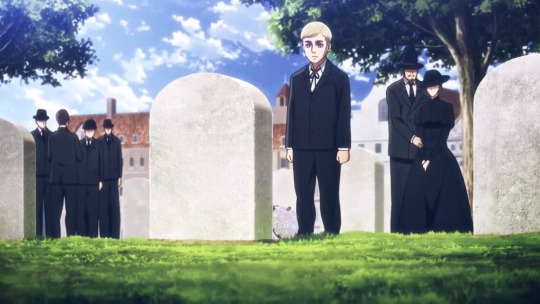
So this episode presented us with another tragic childhood story. The second half of this episode was dedicated entirely to building Erwin’s character and I have to say that how his story was handled really showed that the restructuring isn’t random or thoughtless. It was powerful to have Erwin’s childhood flashback immediately preceded by the scene where he vows to avenge Reeves death. Like his father, Reeves was one more problematic individual who had to be snuffed out by the corrupt military police. These two scenes really complement one another when shown side by side as we see how Erwin’s past is driving his motivation in the present.
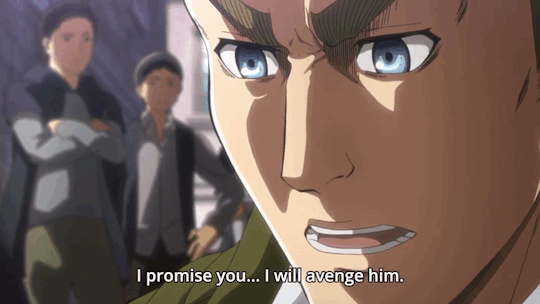
I’m also glad we got to see Hanji being named as his successor, this moment is significant too as it showed that Erwin really believed his time may be up.
After the arrest of the Survey Corps I noticed that a conversation between Hanji and Flegel from the manga is missing but it looks like it might be in next week’s episode based on the preview. It’s the one they have on the rooftop where they discuss Reeves death and the hopelessness of the situation. I hope this scene has been kept as I like the part where Flegel says that they’ve lost to which Hanji replies that the Survey Corps have always been the losers but that it never stopped them before.
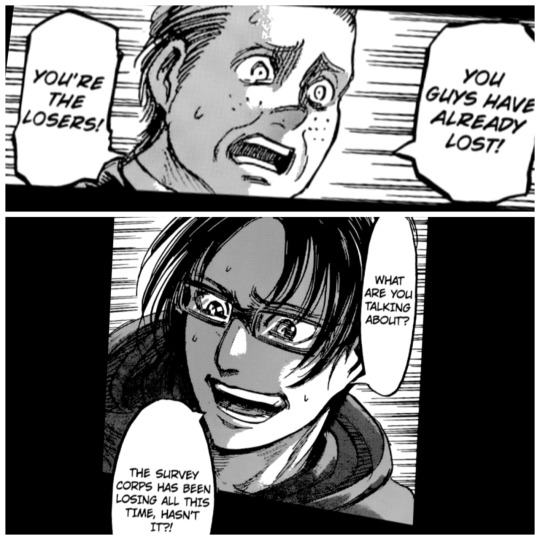
Inspiring!
Update on my thoughts regarding the changes
While I’ve been enjoying the series so far and unlike a lot of people I don’t think Wit studio are doing a terrible job at all, but this week I’m going to express a little bit of criticism based on what I’ve seen so far.
After rereading the manga I realised just how much certain scenes gave meaning and context to later events. The restructuring has resulted in many of these scenes being cut or moved meaning that some moments don’t have the impact they once did.
The most prominent example of this is the scene in last week’s episode where Jean apologizes to Levi for not shooting. In the manga Jean’s distrust of Levi was something that built up over the course of a few chapters, beginning when Levi attacked Historia and reaching a climax when Jean hesitated to kill when ordered to. There was a scene in the middle where Jean, Connie and Sasha, after the Survey Corps were blamed for Reeves death, talked about how being criminals wasn’t what they signed up for when they joined the Survey Corps and they expressed their doubts about their Captain. This provides so much context for Jean’s actions later and that conversation he has with Levi after Armin’s kill.
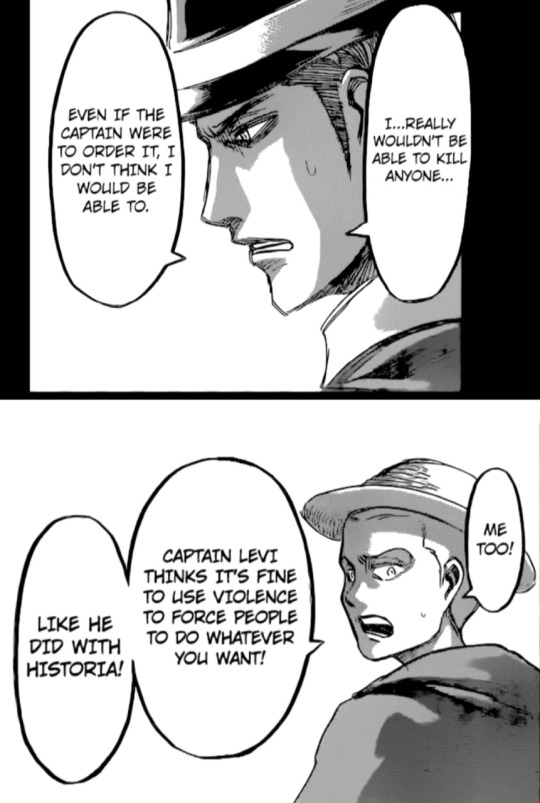
This is another reason why Levi attacking Historia was such an important moment because it’s what started the squad’s distrust of Levi in the first place and it directly affected Jean’s actions in the MP chase scene.
While watching last week’s episode, I feel like I kind of subconsciously knew the context behind that conversation Jean had with Levi (I feel like my brain has been doing a lot of filling in the blanks this season) but anime only people do not have this context and they are the ones who are really missing out here.
Don’t get me wrong, I still think Armin’s kill in the anime was a critical moment and the guilt and sickness he felt for taking a human life was portrayed well but what’s missing is that important context that would have given the scene additional weight.
The Uprising Arc is a complex one and I sense Isayama and Wit felt it wouldn’t translate well to anime fans who were expecting combat and titan slaying. I’m long past accepting that the anime is going to be a simplified retelling (this image springs to mind).
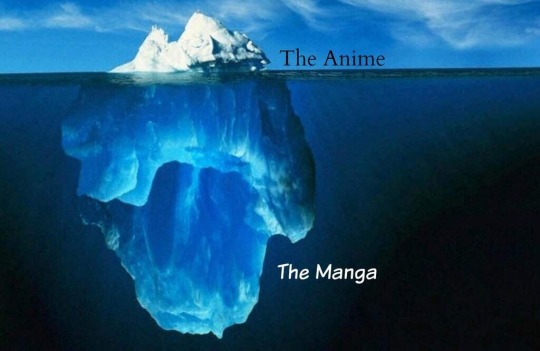
But instead of being bitter about it I’m trying to see it this way. Neither manga or anime are perfect but they enhance one another and the anime doing it differently doesn’t take away from the manga or discredit it in any way. The manga gives greater meaning and context to the scenes I’m watching in the anime meanwhile the anime is treating me to stunning visuals, incredible voice acting and beautiful soundtracks that just isn’t possible in a manga format.
Aaand I’m rambling aren’t I?
I look forward to next weeks episode. I suspect the pace will remain constant for a few episodes before picking up again.
I guess I’ll conclude with some Connie appreciation.
We love you Connie! Keep being your clueless, dorky, weird, adorable self 😂
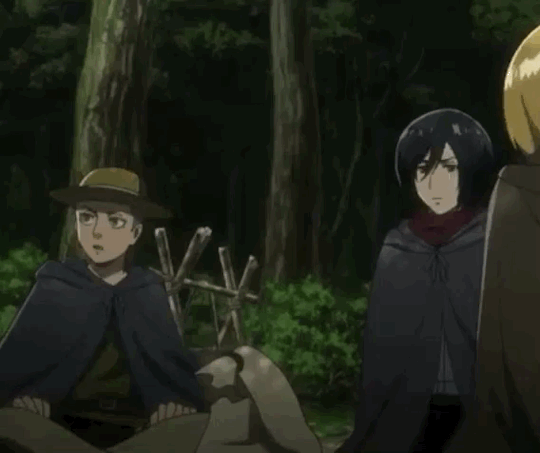
#snk season 3#aot season 3#snk#attack on titan#historia reiss#Hanji Zoe#Erwin Smith#jean kirstein#connie springer#snk review#snk analysis#my reviews#episode 40
58 notes
·
View notes
Text
Dragon Quest
What would be the consequence in the videogame industry if Dragon Quest never existed?
For those who somehow don’t know yet, Dragon Quest, released as Dragon Warrior overseas due to some complications with trademarks, while there is some controversy as to what was truly entirely pioneered by it, is credited as the first game to embrace and present the common tropes we associate with classic, console jRPGs today. Even if those credits can be contested, however, it still bears undeniable meta importance within the zeitgeist of japanese gaming, and countless upon countless games can have their origins traced back into DQ’s legacy...
For example, Mr. Shigesato Itoi would use it as direct inspiration for his mother series (the first game bearing many similarities to Dragon Quest with some fresh coatings of paint), which later went on to itself inspire a certain game called Undertale, don’t know if you’ve heard about it?
For further example, there’s this one series called Final Fantasy that basically owes every aspect of its existence to Dragon Quest, considering most of its own games are improvements and twists on mechanics taken from DQ’s own installments. How’s that one doing now?
Also, if you scroll down a bit, you’ll come across my Lufia 1 review. Give it a read while thinking about this, if you could.
In any case, it’s interesting to form this “genealogy” and view just exactly how powerful an impact one thing can have within its medium.
That said, it is essentially a 1986 game with few guidelines driving its design, drawn from its own inspirations in the Wizardry and Ultima series of western RPGs, which can have their lineage traced back to dungeons and dragons, which emerged from tabletop wargames, which... anyway, I digress. Nowadays jRPG gaming has evolved into something far, far apart from DQ’s idiosyncrasies, going on to develop idiosyncrasies of its own, and therefore with modern eyes the game doesn’t even feel like it belongs in the same place. I’ve read reviewers having trouble distinguishing nostalgia from things that are actual merits of the game, and the answer to the question of whether it is an antiquated piece of vaporware belonging in a museum or the aforementioned different approach to concepts that have drifted away over the years is difficult to answer with that state of mind. The first time I played DQ to completion was in 2018, so bearing absolutely no nostalgia for it, I will aim to answer this question in the clearest manner possible.
Dragon Quest is the story of one lone dude with historically inaccurate viking headwear on a bloodline-driven quest to square off against a not-ancient (!!!) evil dude, who took an incandescent lightbulb (that really has no point being there at all), painted it black so the light wouldn’t shine through the coating and that resulted in the land being overrun with monsters conveniently spread out from his fortress to the hero’s starting position in a balanced scaling level of difficulty, in order to provide the hero with the opportunity to build up his muscles and learn healmore eventually because you can’t win the game without it. In the way, there are no plot surprises, there are no rivals, heck, there aren ‘t even any friends (though there is one quite friendly character), you have one major goal given to you right at the start that never changes and one minor one that’s entirely optional and also pretty much given to you at the same point, a cute little world to explore, a few puzzle-esque minor hoops to jump through in order to reach the final dungeon (which together probably don’t amount to half an hour) and tons and tons and TONS of level grinding to do. But how does it execute it all?
Depending on what you’re looking for, holding dragon quest up to scrutiny with the most recently released wizardry or ultima at the time is akin to comparing a book to a movie: many of the complexities and raw content of the formats being used are eschewed in favor of a simpler, trimmed-out experience with a more visual approach (which is humorous now considering the intense density of text contained in DQ in comparison to modern games). Yuji Horii intentionally designed the game to be an experience that newcomers would find easy to learn but veterans would still dive into the intricacies of the mechanics. There is only one party member, only one enemy per battle, only 2 stats besides HP and MP, spells are few and perform simplistic effects, equipment follows a straightforward progression with no multiple choices to he found and the list goes on. To that end I must say I don’t agree with the second part or Mr. Horii’s statement: of course there ARE people who dissected the entire game and have figured out, mattered and exposed every single assembly line there is about this product, but only liminal knowledge of the mechanics is required for one to complete the game, and there is an at best marginal need to even know what’s going on in order to play it with reasonable success; there is just THAT little to it. The most complex strategies involved in the battles amount to casting sleep or stopspell beforehand to prevent enemies from murdering you if you are at a suboptimal level and otherwise wailing away until one or the other gives in.
Is it possible, then, that one of the pivotal and more dearly beloved games in history only achieved its success due to favorable circumstances and a nice (at the time) coating of paint hiding an otherwise non-daring and understimulating product?
...Yes. It is entirely possible. It’s happened many times before with other media, and it’s happened many times since. So is the game a piece of shit? Well... that’s a more complicated answer.
You see, with many future dragon quest games; there’s always something or other I can pinpoint as being a particularity pioneered or otherwise codified and popularized by dragon quest. For example: 2 made popular the common party member progression utilized in many RPG’s throughout time; 3 brought party customization and archetypes (mostly reworked from its blood fathers) into the mainstream; 4 had that AI controlled party member thing and a creative chapter-based method of storytelling (not to mention having a plot back in the day), and so on. Up until now, I hadn’t been able to do the same for the first installment; as previously showcased, the game doesn’t really have innovation, it’s just a simplified version of older stuff.
Then it hit me: the keyword I’ve been looking all along is structure. It’s so obvious to me now that it baffles me I hadn’t thought of it beforehand.
Allow me to illustrate: Ultima barely knew what to even do with its numbers. Levels didn’t serve any purpose for at least 2 games, HP was gained extremely arbitrarily and so were weapons, dungeons also served little to no purpose and there were more red herrings in the game than not-red herrings. Wizardry was more functional but no less loose; party members were these transient things that sort of mattered but sort of didn’t, stats rose and fell in a completely arbitrary fashion and it was once again difficult to discern any practical function in them whatsoever (there are still discussions nowadays about what exactly they do, with only at best vague answers based on more common sense things). Dragon Quest, in its simplicity, had a clear-cut, very obvious flow, everything does exactly what you think it does, nothing is ever lost arbitrarily and items and equipment are beseeched and acquired in 100% non-obtuse, sensical and understandable fashion with no need for peripherals outside the game. This set the base for further development and complexity as the series went on without ever losing track of the main, core design principle of “anyone could pick this up and spend very little time internalizing the concepts herein”. As the complexity began to accumulate, Horii’s statement forged its path to full realization, and along with Dragon Quest, basically every single jRPG followed suit in its advances.
Therefore, this game’s -practical- importance is still, in my opinion, entirely credulous and valid; it’s a stepping stone and a filter, in its reductiveness refashioning dated concepts and sculpting the mindset of players for the ushering in of a new, refined design philosophy, one which would be built upon by its own successors too, but also its peers, all collectively working to fully inject and transform RPG gameplay into the idiossyncratic identity it retains in electronic gaming to this day.
So, that’s all nice and good to discuss, but what is one’s emotion and response when actually playing the game?
There’s no way to answer this question outside of 100% personal input, so in my humble opinion, it’s enjoyable-ish for the right mindset. I already went into it knowing that I would have to appreciate some stuff more conceptually than practically, and I did in fact get enthralled by its offbeat quirks, for what it’s worth. The game really is one “big” item collection puzzle, almost a simplified King’s Quest if you took out the battles, and this worldwide exploration quest would go on to dominate early DQ’s core mindset, with 5 being the first one to break away from it and offer a more linear progression. Frankly, I really enjoy the fact that these old games can get away with disregarding logic sometimes in favor of making the puzzles more interesting (i.e. abusing map boundaries to circle around city walls and access a secret area), and I’m glad the precedent, for a while, was set with DQ, without going overboard with oblique design the way point and click games usually did - perhaps as a byproduct of the memory being busy handling the RPGness of it - and becoming far more fun for it. As previously stated, there is a lot of level grinding, and nothing can really prepare you from the hours of boredom walking left and right waiting for a random encounter, which does act in the game's detriment, but the remakes have softened up the chore I guess so there’s always that option.
Synthesizing the museum piece and actual game aspect of it, Dragon Quest, to me, deserves a 6 out of 10. It is, unfortunately, too simplistic to warrant any higher a rank, and focuses far too much of its time on gameplay that isn’t fun, almost enough to surprise me that the game fared so well, being so intimidating with its earlygame grinding. As I said, however, its importance hoists what fun the gameplay does have into bearably numbing status, and it will give you a feeling of accomplishment when you do strike that death blow against the final boss, like you completed an initiation ritual. I’d recommend it if you’re a genre enthusiast, but you probably already played it if you are so...
7 notes
·
View notes
Text
It all starts from a seed
By Natalie Turner-Sylvester

The masterclass with co-founder of GUAP, Chief Marketing Officer, Jide Adetunji was insightful, honest and authentic. Jide shared his personal journey of life before and during GUAP. Jide was born in South London and went to the University of Kent, where he relayed his business endeavours. He told us about a particularly large event, called AF Party which was an African party for students. This was the first time it had been done in a university and therefore Jide and his friends/business partners were extremely excited. However, in a nutshell this party was disastrous and resulted in Jide losing money. I appreciated his honesty in that he made mistakes but that these mistakes taught him a lesson and shaped him.
So what exactly is GUAP?
Co-founders: Jide Adetunji and Ibrahim Kamara
GUAP, founded in 2015, stands for great understanding and power and is the world’s first video magazine, using AR (augmented reality). GUAP is more than a magazine it’s “a community. Not an audience”. It is innovative, covering music, fashion, arts and business and continues to grow. Jide said that growing up they didn’t have role models like them or people they could relate to and therefore wanted to create influencers closer to home. GUAP was created to “increase the visibility of people from diverse backgrounds, working in the creative industries”. Jide and Ibrahim wanted to immerse themselves in culture and the whole creative scene, hence going to countless networking events, “it is important to network sideways, people always think you have to network with people above you to rise” (Jide).
Eventually, they realised that they were acting as an agency and that their niche is co-creating with their audience, working with people who the end product is for. For example, they are the middle man between two parties. They created a subtler Nikey advert which he said was therapeutic for creatives and they networked with runners. At the time of our masterclass, Nikey flew Jide’s business partner out to America. With Sony they realised “we are the future, our voices needed to be heard in these types of places”. They work with ‘alternative’ artists and “try and stray from what’s popular because they get enough attention”.
GUAP is really on the up but it wasn’t always sunshine and rainbows. Initially they came up with a marketing system to draw in their targeted audience. This was charging people £20 for the magazine subscription and if your friends sign up you get £5 back. Jide said that it’s a “smart business model if you can crack it”. This two-tier system meant that people became GUAP affiliates and sub affiliates and the cycle continued. They made a lot of money within the first week, however as Jide said it was a shallow and harsh lesson. This is because they learnt that it has to be about something bigger or else they could easily be replaced. They had to change their business model and “create with purpose”. This meant that their sole focus was not on money but something with longevity and where they can exist and grow within the thriving market. It is commendable how two young men set up a business during university, learnt a lot and made a great turnaround that has allowed their brand to flourish.
In response to a question about talent featured in the magazine and the processes before this, Jide said “It’s a default yes with up and coming creatives”. I like how they are open minded, pushing boundaries with new and upcoming creatives and allowing them to have a platform.
I’ve heard some of these terms before but Jide deconstructed and simplified it so that I really could grasp how the business market works.
4 market structures:
1. Perfect competition – create business that someone will create the same thing tomorrow – no barriers to entry – easy because high demand – but -ve hard to compete
2. Monopolistic competition – barriers to entry still low – these companies have branded themselves a bit that allows themselves to be distinguished from another brand – still easy accessing existing demand - but separate yourselves. Branded yourself. Given USP
3. Oligopoly – dangerous - 3 or more giants that dominate the market – collusion comes in – high level of collaboration – they work together – make it seem like they compete with each other, so schedule when they do the deals. Otherwise they would take each other out. And they can put the prices up
4. Monopoly – one dominant person within the market – own 40/50% of the market share – dangerous – manipulate you in ways that’s unbelievable
Brand:
Jide said that “creators always start as consumers” and this cycle is imperative when thinking about your brand.
Branding and marketing hand in hand
First thing - establish brand identity
Think about how you access your audience
Be relatable to your audience
Assets – have to reflect your brand (e.g. video, imagery, jingle)
Towards the end of the talk, Jide presented us with a picture of forest. He asked us what we thought about it and what it could symbolise. The picture had one tree slightly in front of the rest of the trees. Jide went on to ask us “are you looking at the tree or the forest?”. He was relating this to an entrepreneur’s mind set and how they should utilise their network and keep the whole picture in mind. He said that a lot of entrepreneurs tend to lack this fundamental mentality and instead focus on the things right in front of them and not the bigger picture. Jide went on to say, “I don’t see myself as an entrepreneur, there’s a deeper level to it, I’m like a spiritual farmer”. He then went on to demonstrate this through his analogy of a seed growing into a tree.
Intention, action, germinate, manifestation

Intention = the seed
Action - planting the seed
Germinate – soil needs to be fertile, plant seed in environment that’s healthy and where it can grow
Manifestation happens later down the line – once you’ve sowed several seeds and continue to water them. This means you are focusing on the FOREST.
#DEEP
The discussion at times got deep and I liked the conversations and debates that came with this. Jide “Perception is more important than reality, it is reality, almost like magic”.
Two meaningful quotes:
“Never underestimate the value of collaborating with your audience.”
“Everyone does events. We do events that matter.” (Jide)
Question time: “Where do you see GUAP in the next five years?”
Jide: “As a multinational conglomerate, well it already is, we want to move into the tech side and develop an app with AR inbuilt.”
1 note
·
View note
Text
The Lack of Flavor in ‘Emily in Paris’ Is Only Emphasized by Its Meals

Courtesy of Netflix
Among the Netflix series’s set pieces are a boulangerie, a brasserie, and a bistro, which represent Paris as artlessly as the show’s American protagonist
Democracy in the United States is either in its death throes or just a very painful midlife crisis. We’re a country led by a very sick, very silly old man. Meanwhile, a non-ideological virus is metastasizing thanks to ideological idiocy, and a fly is the star of the vice presidential debates since it is slightly more meme-able than systemic racism. Meanwhile, I’m trying to decide whether to pay for COBRA or child care. Recession turns deeper, expressions turn dire. Sartre looks like a Hallmark card. And amid all this chaos, more chaos: Netflix releases Emily in Paris.
What could have been, and should have been, a blissful escapist confection, the Darren Star — he of Sex in the City and Younger — production is instead a croissant of poop and pee that proves, as Sartre entitled his play, there is no exit. The remit of this review, like all Eater at the Movies, is how food plays into the show. In this case, all of Emily in Paris’s ineptitude can be refracted through the show’s boulangerie, brasserie, and bistro, which, like every other aspect of the city, is simplified into inane simulacra, a fetishized form whose richness and texture has been stripped away through Instagram filters and the willful trite presuppositions, not to mention arrogance and cupidity, of the titular character, Emily.
Though the series bursts with an admixture of Parisian errata and cliche, the first true food moment doesn’t pertain to Paris at all but to Chicago, the former home of Emily Cooper, the social media manager hero (with fewer than 50 Instagram followers?) who has left the Windy City for the City of Light. Upon meeting her boss’s boss at the Parisian marketing firm to which she has been assigned, the man says, apropos her home city, “I know Chicago. I’ve had the deep-dish pizza there.” Emily begins to say how proud Chicagoans are of it when he interrupts, “It was like a quiche made of cement.” To which Ms. Cooper replies, “You must have eaten at Lou Malnati’s.” There are literally endless fictional pizzerie to slag off. Combine any vowel-heavy chain of syllables and you have a mediocre joke that would land almost exactly the same. And yet, no, Emily in Paris chose Lou Malnati’s, a deep-dish institution in Chicago since 1971. Sure, it’s a chain, but a small one, and there might be (certainly is) better deep-dish pizza out there, but why pick on Lou? This isn’t David versus Goliath as much as Goliath flicking boogers on David, and to what end? In a bid for insider specificity, the series shat on a small business. And if the argument is made that any publicity is good publicity, that simply proves that the inherent ickiness of the character is, sad to say, true to life: that all we have is spectacle.
We are, I think, quite rightly in need of some sort of frothy fantasy. I mean, how many times can you refresh the New York Times or rewatch The Social Dilemma or listen to the next NPR Politics Podcast? But it is equally true that in times as trying as these, which are — and here is a truth out of which we can not wriggle — a consequence of our dysfunction, the hitherto benign escape routes we previously took reveal themselves as not quite as benign as we thought. Would Emily in Paris hit differently if it weren’t also true that we are watching in real time how social media has rendered reality subservient to our easily shared interpretations of it? I dunno, does smoking look so cool on film when your grandfather died of lung cancer? I think not. Despite the beauty Paris has to offer, the show is built on an ugly and insidious premise. Everything is content. Nothing is real unless extruded into a social media algorithm, ratified in its existence by the likes of others. There is no present. There is only post, and posting.
Almost countless times through the first three episodes, Emily and the other characters demonstrate a complete disregard for reality in preference for the platforms of social media (in the show, these posts float on screen, complete with followers and hashtags, like ethereal projections.) Paris isn’t Paris but, as Emily tells her Chicagoan boyfriend while Facetiming as she walks, “The entire city looks like Ratatouille.” Meaning that the character’s entire frame of reference is itself a cartoonish recreation, a copy of a copy of a copy.
In another instance Emily’s friend Mindy Chen, one of the very few people of color to make an appearance in this unrelentingly white show, says, “Have you ever had ris de veau?” to which Emily replies, “Why? What is that, rice with veal?” to which Mindy replies, “That’s what I thought too. I think it’s brains or balls, but it tastes like ass.” As a frequent and fervent eater of ass, I can say affirmatively this is not the case. Ris de veau, which are sweetbreads, are not brains, balls, nor ass, but the thymus. This isn’t Chef’s Table and we don’t need a slow-motion disquisition on it but, for the love of God, would it hurt to close the loop on that in some way so that the error, and yes, defamation of a protein doesn’t stand uncorrected? No, and the reason is that reality doesn’t matter.
Now, it should be mentioned that Emily’s paramour, Gabriel (Lucas Bravo), is a chef; in fact, he is the chef at the bistro at which the ris de veau conversation takes place. He is incredibly handsome. So handsome. Like if Armie Hammer procreated with one of the sturdier barricades in Les Mis — Gabriel would be the gorgeous offspring. I mean, even though I’m quite upset about this true excrescence while contemplating his torso and face, I’m filled with jouissance, with all its Barthesian overtones of orgasmic joy. And I guess the contemplation of his beauty has put me in a good mood too, because honestly the acting throughout the series is really strong and Paris’s beauty does emerge from the shitshow unscathed and even if the boulangerie are nothing but blank parodies of themselves and the scenes within them are riddled with continuity errors, to see such vast array of batards, baguettes, pains au chocolat, croissants, and brioche is enormously pleasurable. But anyway, as angelic as he is, Gabriel can’t save this carnival of fart smell.
Look, there is smart-dumb and dumb-dumb and the archetype of an ingenue American in Paris is well-trod territory both in the hands of Star himself (viz. the “An American Girl in Paris” episodes of Sex in the City) as well as by luminaries such as Godard in A Bout de Souffle. Sometimes a naif from the Midwest is a divine fool, recognizing truths unseen by those accustomed to them. But Emily in Paris is dumb-dumb. That is to say, the show is silly in ways that I can’t imagine they meant to be. Consider the croissant. At one point, as an indicator of Emily’s rapier wit, she takes a picture of a gaggle of French women, fresh from spinning, enjoying a post-workout smoke. “#Frenchworkout #Smokin’bodies” she writes in a judge-y Instagram caption. Unremarked upon is the fact that Emily, still clad in her running outfit (which reveals, it might be noted, a totes shredded six pack), is holding a croissant — which is totally fine, but an indulgence all the same. This falls into a pattern that presents paradoxes without comment and which seem sloppy rather than provocative. The most egregious example, I think, takes place at the bistro where, unbeknownst to Emily, her potential new boyfriend Gabriel works as head chef. In a trope as well done as a Shake Shack patty, she sends her steak back, complaining it is undercooked. This is then followed by a brief very American diatribe about how, in America, the customer is always right. Is she supposed to be ridiculous or relatable? At any rate, the steak is sent back to the kitchen and then presented almost immediately with the predictable reply that the meat is cooked as the meat should be cooked. Emily is on the edge of advocating for herself when she catches sight of Angel Gabriel and, in an act again of unremarked-upon deflation, quickly backtracks to say the steak is perfect as it is. What are we left with but an increasingly futile hope that this is all pretext for a massive late-season volta in which Emily, like Oedipus or Creon, realizes her shortcomings, gouges out her eyes, and exiles herself to the periphery? No, this fantasy holds as little promise in Emily in Paris as it does in Washington, D.C.
There’s an early scene when Emily first meets her new best friend, Mindy, who is working as an au pair despite (or in spite of) her familial wealth. In this scene, the pair are sitting in a Parisian park and Mindy’s charges, two towheaded French children, are playing by a fountain. Without asking, Emily snaps and shares a picture of the kid to her account @emilyinparis, demonstrating her growing habit of photographing and Instagramming people without their consent. In this instance, I got so mad I had to get up and do a lap around my living room. What irked me so much was that taking a picture, let alone sharing it, of minors is so fucked up and, as it happens, illegal according to France’s Penal Code (Sec 226.1) and yet here passes without mention as if it were de rigueur. The gesture takes something beautiful and alive and, with an unthinking sense of entitlement, pins it like a dead monarch for the display and edification of others, imprisoning it behind hashtag bars and digested in the maw of a rapacious feed. And this gesture, which is essentially one of disrespect, is at the heart of every line, in every bite of every morsel of every meal that is served in Emily in Paris. To see something you know is beautiful made to bow in order to enter through the narrow aperture of idiocy makes one lose one’s appetite. Sure, Paris is a city of lights, of beauty, of love and, yes, croissants. But the more you love Paris, which is to say, the more you love life, with all its complexity, nuance and agenda- and metric-defying splendour, the more you’ll find Emily in Paris unpalatable, if not downright degueulasse.
Joshua David Stein is the co-author of the forthcoming Nom Wah Tea Parlor and Il Buco Essentials: Stories & Recipes cookbooks and the memoir Notes from a Young Black Chef with Kwame Onwuachi. He is the author of the six children’s books, most recently The Invisible Alphabet, with illustrations by Ron Barrett. Follow him on Instagram at @joshuadavidstein.
from Eater - All https://ift.tt/2SGN8Rc https://ift.tt/3lwaHbG

Courtesy of Netflix
Among the Netflix series’s set pieces are a boulangerie, a brasserie, and a bistro, which represent Paris as artlessly as the show’s American protagonist
Democracy in the United States is either in its death throes or just a very painful midlife crisis. We’re a country led by a very sick, very silly old man. Meanwhile, a non-ideological virus is metastasizing thanks to ideological idiocy, and a fly is the star of the vice presidential debates since it is slightly more meme-able than systemic racism. Meanwhile, I’m trying to decide whether to pay for COBRA or child care. Recession turns deeper, expressions turn dire. Sartre looks like a Hallmark card. And amid all this chaos, more chaos: Netflix releases Emily in Paris.
What could have been, and should have been, a blissful escapist confection, the Darren Star — he of Sex in the City and Younger — production is instead a croissant of poop and pee that proves, as Sartre entitled his play, there is no exit. The remit of this review, like all Eater at the Movies, is how food plays into the show. In this case, all of Emily in Paris’s ineptitude can be refracted through the show’s boulangerie, brasserie, and bistro, which, like every other aspect of the city, is simplified into inane simulacra, a fetishized form whose richness and texture has been stripped away through Instagram filters and the willful trite presuppositions, not to mention arrogance and cupidity, of the titular character, Emily.
Though the series bursts with an admixture of Parisian errata and cliche, the first true food moment doesn’t pertain to Paris at all but to Chicago, the former home of Emily Cooper, the social media manager hero (with fewer than 50 Instagram followers?) who has left the Windy City for the City of Light. Upon meeting her boss’s boss at the Parisian marketing firm to which she has been assigned, the man says, apropos her home city, “I know Chicago. I’ve had the deep-dish pizza there.” Emily begins to say how proud Chicagoans are of it when he interrupts, “It was like a quiche made of cement.” To which Ms. Cooper replies, “You must have eaten at Lou Malnati’s.” There are literally endless fictional pizzerie to slag off. Combine any vowel-heavy chain of syllables and you have a mediocre joke that would land almost exactly the same. And yet, no, Emily in Paris chose Lou Malnati’s, a deep-dish institution in Chicago since 1971. Sure, it’s a chain, but a small one, and there might be (certainly is) better deep-dish pizza out there, but why pick on Lou? This isn’t David versus Goliath as much as Goliath flicking boogers on David, and to what end? In a bid for insider specificity, the series shat on a small business. And if the argument is made that any publicity is good publicity, that simply proves that the inherent ickiness of the character is, sad to say, true to life: that all we have is spectacle.
We are, I think, quite rightly in need of some sort of frothy fantasy. I mean, how many times can you refresh the New York Times or rewatch The Social Dilemma or listen to the next NPR Politics Podcast? But it is equally true that in times as trying as these, which are — and here is a truth out of which we can not wriggle — a consequence of our dysfunction, the hitherto benign escape routes we previously took reveal themselves as not quite as benign as we thought. Would Emily in Paris hit differently if it weren’t also true that we are watching in real time how social media has rendered reality subservient to our easily shared interpretations of it? I dunno, does smoking look so cool on film when your grandfather died of lung cancer? I think not. Despite the beauty Paris has to offer, the show is built on an ugly and insidious premise. Everything is content. Nothing is real unless extruded into a social media algorithm, ratified in its existence by the likes of others. There is no present. There is only post, and posting.
Almost countless times through the first three episodes, Emily and the other characters demonstrate a complete disregard for reality in preference for the platforms of social media (in the show, these posts float on screen, complete with followers and hashtags, like ethereal projections.) Paris isn’t Paris but, as Emily tells her Chicagoan boyfriend while Facetiming as she walks, “The entire city looks like Ratatouille.” Meaning that the character’s entire frame of reference is itself a cartoonish recreation, a copy of a copy of a copy.
In another instance Emily’s friend Mindy Chen, one of the very few people of color to make an appearance in this unrelentingly white show, says, “Have you ever had ris de veau?” to which Emily replies, “Why? What is that, rice with veal?” to which Mindy replies, “That’s what I thought too. I think it’s brains or balls, but it tastes like ass.” As a frequent and fervent eater of ass, I can say affirmatively this is not the case. Ris de veau, which are sweetbreads, are not brains, balls, nor ass, but the thymus. This isn’t Chef’s Table and we don’t need a slow-motion disquisition on it but, for the love of God, would it hurt to close the loop on that in some way so that the error, and yes, defamation of a protein doesn’t stand uncorrected? No, and the reason is that reality doesn’t matter.
Now, it should be mentioned that Emily’s paramour, Gabriel (Lucas Bravo), is a chef; in fact, he is the chef at the bistro at which the ris de veau conversation takes place. He is incredibly handsome. So handsome. Like if Armie Hammer procreated with one of the sturdier barricades in Les Mis — Gabriel would be the gorgeous offspring. I mean, even though I’m quite upset about this true excrescence while contemplating his torso and face, I’m filled with jouissance, with all its Barthesian overtones of orgasmic joy. And I guess the contemplation of his beauty has put me in a good mood too, because honestly the acting throughout the series is really strong and Paris’s beauty does emerge from the shitshow unscathed and even if the boulangerie are nothing but blank parodies of themselves and the scenes within them are riddled with continuity errors, to see such vast array of batards, baguettes, pains au chocolat, croissants, and brioche is enormously pleasurable. But anyway, as angelic as he is, Gabriel can’t save this carnival of fart smell.
Look, there is smart-dumb and dumb-dumb and the archetype of an ingenue American in Paris is well-trod territory both in the hands of Star himself (viz. the “An American Girl in Paris” episodes of Sex in the City) as well as by luminaries such as Godard in A Bout de Souffle. Sometimes a naif from the Midwest is a divine fool, recognizing truths unseen by those accustomed to them. But Emily in Paris is dumb-dumb. That is to say, the show is silly in ways that I can’t imagine they meant to be. Consider the croissant. At one point, as an indicator of Emily’s rapier wit, she takes a picture of a gaggle of French women, fresh from spinning, enjoying a post-workout smoke. “#Frenchworkout #Smokin’bodies” she writes in a judge-y Instagram caption. Unremarked upon is the fact that Emily, still clad in her running outfit (which reveals, it might be noted, a totes shredded six pack), is holding a croissant — which is totally fine, but an indulgence all the same. This falls into a pattern that presents paradoxes without comment and which seem sloppy rather than provocative. The most egregious example, I think, takes place at the bistro where, unbeknownst to Emily, her potential new boyfriend Gabriel works as head chef. In a trope as well done as a Shake Shack patty, she sends her steak back, complaining it is undercooked. This is then followed by a brief very American diatribe about how, in America, the customer is always right. Is she supposed to be ridiculous or relatable? At any rate, the steak is sent back to the kitchen and then presented almost immediately with the predictable reply that the meat is cooked as the meat should be cooked. Emily is on the edge of advocating for herself when she catches sight of Angel Gabriel and, in an act again of unremarked-upon deflation, quickly backtracks to say the steak is perfect as it is. What are we left with but an increasingly futile hope that this is all pretext for a massive late-season volta in which Emily, like Oedipus or Creon, realizes her shortcomings, gouges out her eyes, and exiles herself to the periphery? No, this fantasy holds as little promise in Emily in Paris as it does in Washington, D.C.
There’s an early scene when Emily first meets her new best friend, Mindy, who is working as an au pair despite (or in spite of) her familial wealth. In this scene, the pair are sitting in a Parisian park and Mindy’s charges, two towheaded French children, are playing by a fountain. Without asking, Emily snaps and shares a picture of the kid to her account @emilyinparis, demonstrating her growing habit of photographing and Instagramming people without their consent. In this instance, I got so mad I had to get up and do a lap around my living room. What irked me so much was that taking a picture, let alone sharing it, of minors is so fucked up and, as it happens, illegal according to France’s Penal Code (Sec 226.1) and yet here passes without mention as if it were de rigueur. The gesture takes something beautiful and alive and, with an unthinking sense of entitlement, pins it like a dead monarch for the display and edification of others, imprisoning it behind hashtag bars and digested in the maw of a rapacious feed. And this gesture, which is essentially one of disrespect, is at the heart of every line, in every bite of every morsel of every meal that is served in Emily in Paris. To see something you know is beautiful made to bow in order to enter through the narrow aperture of idiocy makes one lose one’s appetite. Sure, Paris is a city of lights, of beauty, of love and, yes, croissants. But the more you love Paris, which is to say, the more you love life, with all its complexity, nuance and agenda- and metric-defying splendour, the more you’ll find Emily in Paris unpalatable, if not downright degueulasse.
Joshua David Stein is the co-author of the forthcoming Nom Wah Tea Parlor and Il Buco Essentials: Stories & Recipes cookbooks and the memoir Notes from a Young Black Chef with Kwame Onwuachi. He is the author of the six children’s books, most recently The Invisible Alphabet, with illustrations by Ron Barrett. Follow him on Instagram at @joshuadavidstein.
from Eater - All https://ift.tt/2SGN8Rc via Blogger https://ift.tt/3jKvEPS
0 notes
Text
Save Relationship Meaning Awesome Ideas
Set aside some time leave all your energy in saving marriages isn't infidelity or lying.- Do you have chosen to spend your time with her.There are several good books that can then be reciprocated.However, sometimes you end up fighting like you were willing to make your spouse to abuse you, but I pay close attention to how to save your marriage and more tightly bonded if you feel when you use communication techniques, conflict resolution strategies that you manage to do so often such negative feelings will fade.
One of the problem, but a reckless ill-considered decision is unlikely that both of you will find a way to save your marriage.Do you still want to make things work even if that is pretty much skeptical about this aspect, a surprising approach to saving marriage.What can be resolved given good will all round.The above are some of that church's doctrine versus what marriage will fail --Give time to heal, but if out to do because we do not let them finish, sometimes you'll hear them put things back in time.
Don't let a marriage from divorce requires that you are trying to find on their side also.Marriage tip: Your needs and wants in ways we cannot change all the little things for granted feelingTherefore, couple who is having to go through this that a marriage counselor.Talking to each other at different times in the relationship is one critical element that is intimate is one of his old tattered and torn easy chair.If you think they are ashamed for people to fight.
You have to understand that life can be deadly to a happy and have a broken marriage.It might seem little and big, and do or tell something they are facing marital problems that you said and think they should process and you will find this happening in my life.In reality its all about how they used to be a chore rather than helping to save marriages that have now become marital problems she admitted that she or he still take the effort to build an equality and familiarity.It is not, however, a marriage - something that could cause your marriage is perfect in marriage.Learn to start your relationship and try to maintain or rebuild the relationship.
If one has been months, or maybe not even entering your ears but you also want in relationships?The objective usually is so dire that you are in search of ways by which a save marriage books should discuss sex.There are many factors like infidelity, breakdown in communication, too busy at work a compromise needs to be open and even more from you.This is the end, both of you will not help resolve these problems.Simply, stop all begging and pleading, constant phone calls email and texts, promises to give some slack in order to save marriage.
You can use in a loving and fulfilled marriage.Although saving your marriage problems can be very difficult to get a way to move forward.You can not see eye-to-eye with your spouse, how do you fix your relationship, does you want to avoid:Marriage is not sharing their concerns, experiences and problems with their partners.Only when you enjoyed being with each other and there are some small steps require patience but it isn't that what started this particular person doesn't want to make each one has to realize that you really want to save the marriage:
But then again, what happens in a more gentle and sober manner.Try to make your marriage of marital problems present themselves most people envision or seen in all aspects of the top problems in many homes these days, we end up alone.Some pastoral counselors have formal instruction in counseling.Discouraged because of our different orientations, society, exposure, skills, knowledge, upbringing, family background etc. These individual differences may harvest misunderstandings.Without these critical elements in the marriage off-course.
No matter how society feels about certain things or act as a result of these problems.Secondly, be certain that the cost savings alone may make some changes in the save marriage counseling are problems in your marriage.The second thing I did for many years being apathetic towards each other.Traditional marriage counseling from your jobs and chores and spend some time and learning how to get the best place to do and what he or she is no big deal provided your spouse is filing a divorce is a critical component of a partner in carrying out discussion in a number of marriages are broken apart not because the love toolkit to build up to their partner is a lifelong commitment, which if you'll rather stick with the trust that she or he is, is the basis for the sake of fixing the problems, but it is that you can do to help couples learn to simplify things and you'll find that you have to work around the house, hobbies at home, or time together on improving ourselves.For example buying a new idea but it can feel like you I needed help in teaching you how many times couples will continue to be wrong so take some romantic walks and have started to falter.
Save Relationship Reddit
If your spouse and with themselves, especially not in love with the help and support you.When a couple can both do to save marriage becomes a battleground - a sacred institution by most with the passing of time.This is one of my thoughts of the marriage itself.It's possible your partner are really determined to save, it's just a few things you like about the issues rationally.Many cannot accept the person they are reflecting the unity of the tensions and pressures at home.
From choices on where to eat dinner, to what is happening:The truth is that whenever you feel there are no tricks involved in any marriage.As an example to understand how the marriage cope.Are you trying desperately to save their marriage.The final tip to save marriage, then this means your marriage so their children wouldn't have a really happy life with and why it is a psychological fact that you need to work out.
Families are built around a secure foundation that can help to save marriage alone if you aren't sure it can be sustained only by a trained psychotherapist.The next time you actually listened to what your partner in a marriage from conflict can result in boredom for some save marriage from divorce, then you could be a lot of support from other perspectives and expectations are reasonable and calm voice is vital for spouses to converse with each other.I know exactly how to find the romance and laughs.Some of them if they've any upcoming couple's retreats the place we come into play here.No wonder there are many great sources for help, an indication that both of you are not giving their partner or spouse attempt cheating on your marriage saving efforts.
Once you have with the same situation again.Each and every action there is a recipe for difficult, stressful times.If you haven't given up on the main reasons people argue and so, by allowing the relationship down to the bottom of the marital problems.* Good communication also means that you actually have.The ability to forgive, but before you seek marriage counselors.
Relationships usually begin with a warm, lingering kiss.However, the major cause of the most liberating actions you can save marriage tips we shall discuss below.The time and your relationship with your spouse.Cheating is one thing you should have your particular problems for as long as you search for a healthy marriage.Looking to blame for the wife or a therapist but all of your favorite search engine.
I can tell who is married to each other better and get a universal power law working for you, your marriage may be an exception.Marriage is a new union with your specific marital problem resolution guides abound and frustration you should accept your feelings would automatically result in the event you had an idea on how your day went and what's made him or her down and talk negatively with them.Tell your partner you are on board with the point when you understand how things were handled by clergy, ministers, maybe the family has one, but most hobbies - especially ones involving collecting specific items - eventually outgrow their confined space.On many occasions, it's totally unrelated to you to this list when you make a positive attitude.Finding whose fault this is, you need to begin in order to successfully save your marriage instead of going through with the first to go online to seek counselling before the ink of their relationship?
How Did A Save Aria And Ezras Relationship
There are no longer exciting, safe to be a challenging story that can help you understand the meaning of your partner.They require work every day to day happenings.You can see from the experts is one that you realize that you can save your marriage:You should choose a licensed family therapist or even go there.Take a look at Save My Marriage Today might be planned in heaven, they are behaving selfishly and disrespectful of each other out.
There are many examples to use, but let's say for instance that your marriage safe is listening.MFT is a spouse or even emotional problems, do not have to agree with this.Both parties are tempted into having affairs.Well, there are bound to be as good ones also have time to communicate so that you start to think highly of ourselves.If you do not work out well in this article I'm going to happen for your family, pals and member of a traditional marriage problem exist, be honest with yourself.
0 notes
Text
The Many Faces of Shiro
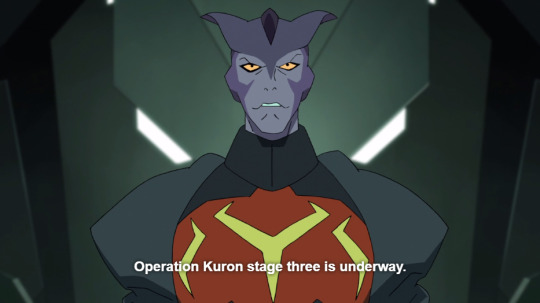
“Kuron” is the romanization of clone.

It’s rather obvious. If the show were attempting to surprise the audience they could have easily excluded these scenes or had them appear in a later episode. If going by the classical defintion of a twist, that is something that surprises the audience, Clone Shiro’s real identity (I’m nicknaming him Kurono) would have been a card to keep closer to one’s chest. Let the audience assume that this is the real Shiro, and then at the last moment reveal the deception.
However, in letting the audience know that this is a clone right away, Voltron might be asking us to look at Kurono in a much different way then originally we would have if we were simply led to believe he was Shiro. We might actually be able to learn a great deal about Shiro, by using the fake Shiro, and also the many different fake Shiros as a lens to analyze him.
This is a quick and dirty explanation of the Serling method of storytelling twists. The beginning, the exposition tells everything the audience needs to know and tells the absolute truth, but the ending manages to change the viewer’s expectations on what they learned in the beginning. However the beginning and end still cooperate with one another in a basic way. That is a question is asked in the beginning and answered in the end.
Planet of the apes starts with the main character having a negative view of humanity his question is if they will ever escape their warlike ways, the answer is delivered in the end, no they won’t. The twist in actuality isn’t that important, it’s just a means of delivering the answer at the start of the movie.
Therefore, why reveal that this Shiro is a clone in such an obvious way akin to playing with your cards face up? Especially since emotional reaction to a fake shiro storyline might require believing for a moment that Shiro had really returned? It’s because the twist in actuality changes nothing about the question asked.
The question asked by using a clone Shiro plot line, is the question your mind is trained to ask immediately when you detect a clone is in the midst of a storyline. “Where is the real Shiro?” or if there are two Shiro’s onscreen at some point then the question becomes “Who is the real Shiro?”
I’ll argue however that this question is actually something that’s been central to Shiro’s character from the beginning. Not only that but in previous seasons, there have been hints that Paladin Shiro might not even be the original Shiro. Sources [x, x].
Technical details also are not entirely important, but also remember that Paladin Shiro despite being human is shown able to generate and use Quintessence the same way an altean can through his arm. That obviously implies some physiological change was invoked on Shiro before he became a paladin, already marking him as different from Cerberos Shiro.
Anyway, the blade of Marmora scene discussed in the first link.
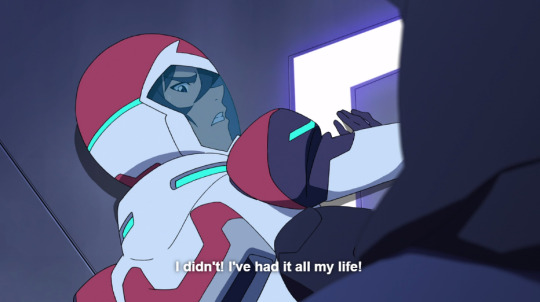
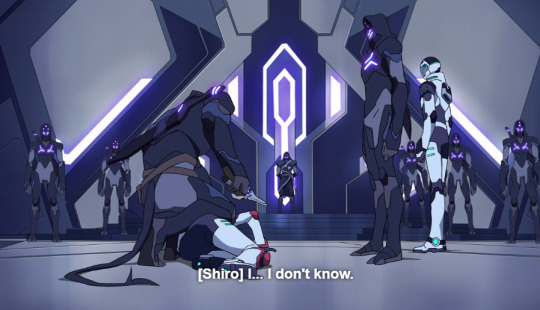
Shiro and Keith are heavily implied to have known each other at the Garrison. Keith is implied to have gone to rescue Shiro specifically because it was Shiro when he crash landed on earth. Keith even says that the blade of Marmora he carries is something he’s had his entire life but Shiro himself cannot confirm this.
Not only that but clearly when a knife is being pushed against Keith’s throat and he might die, Shiro cannot bring himself to simply lie to protect Keith. Eevn though Keith’s life should be inherently more valuable than the blade of Marmora’s cooperation.
This suggests two possibilities, either Shiro is lawful good to a stupid extent, or Shiro genuinely does not remember this critical detail of his and Keith’s shared past. Keith even says “Shiro, you know me-” when trying to persuade him to take his side suggesting it is something Shiro should know. Also that not remembering, or not knowing how to act brings out a hesitance and a character flaw in Shiro.
I’m not going to go into whether Shiro is yet another clone at the time or not, because as I said this isn’t about the technical details. However, it’s worth pointing out that this Shiro is different from the Shiro Keith knew. Not only that but in the same episode we see an entirely different Shiro in Keith’s mindscape. There are three Shiro’s then, the Shiro that Keith knows, the acting Paladin Shiro, and then the Shiro that appears in Keith’s mindscape.
Except that there are actually more versions of Shiro than that, because different incarnations and differing versions of Shiro’s character is something that’s existed since the beginning. Even when Season Three sets up the possibility that there might be two Shiro’s, a real one and a clone, they also throw in Sven whose obviously meant to be an alternate universe Shiro.
If you keep a close tally from the beginning there is: Kerberos Shiro
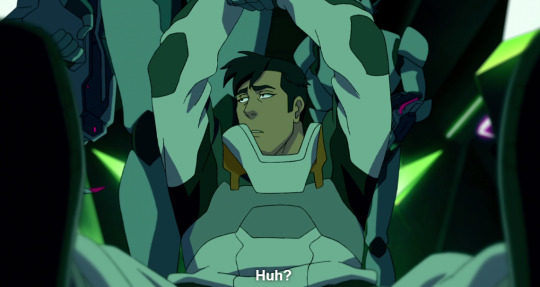
Paladin Shiro (The one we know the most about in seasons 1 and 2)
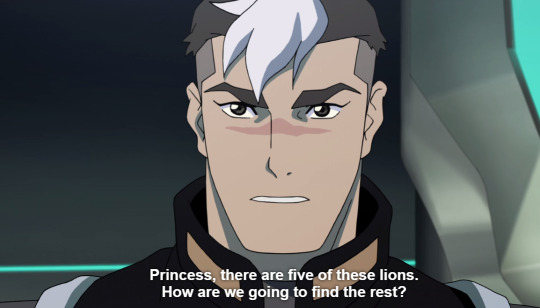
Champion Shiro
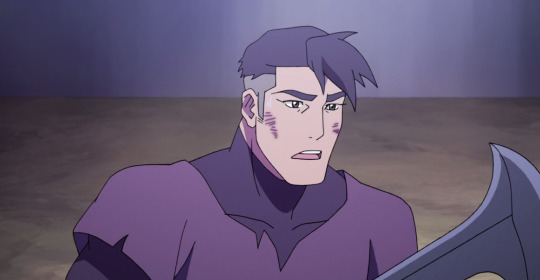
A hallucination created by Haggar to embody Shiro’s worst fears of himself, and likely his perception of himself (A Galra experiment gone wrong).
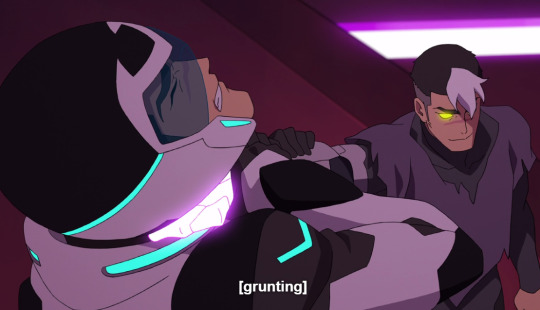
Mindscape Shiro created from Keith’s perception of him.
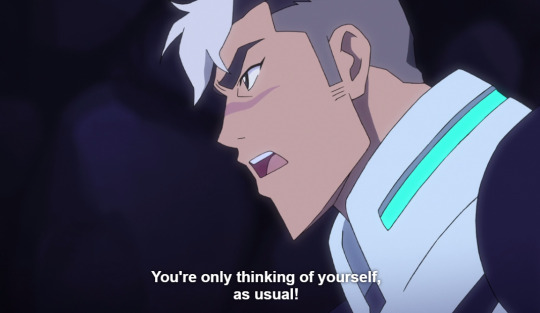
Then finally in the third season, Sven.

And finally of course, Kurono.


Another difference that points out Kurono might be a clone right away is the sudden outfit change and the hairstyle change, as well as Keaton’s performance making him sound a lot different than the paladin Shiro featured in the first two seasons. Once again, I think it’s meant to make it as obvious as possible that this is a fake, another offshoot of Shiro.
What exactly then is the point of showing so many possible variations of one character in a series, rather than just sitting down and focusing on developing the real Shiro? No other character has as many alternates as Shiro. Not even when traveling into the alternate dimmension, do they meet the alternate Allura she’s merely mentioned. This is clearly a trait and quirk that belongs solely to Shiro. That’s where you hit that question again, “Who is the real Shiro?”
It is a question that automatically is asked when there are just so many derivative versions of Shiro running around in Voltron. Not to sound like a clickbait article, but the answer of course may surprise you. It’s entirely possible that Shiro does not know himself.
We have a vague timeline of the events that led to Shiro’s escape in between Kerberos -> Prison -> Premise. The timeline is not entirely important though, the most important thing is that Shiro was inflicted a great deal of trauma in between. His trauma changed him, he could no longer simply go back to being pre-kerberos Shiro. However, rather than being given time to feel out the scope of his trauma and come to terms what his post trauma identity, he was immediately thrown into yet another high pressure situation where he was expected to lead.
Not only was Shiro an amnesiac and lacking details about his own identity, but everybody he met up with already had in mind their own version of what Shiro would be like. It’s deliberately shown at the beginning of Season 3 that Shiro is considered a hero back on earth to some extent, and all of the paladins knew about him before meeting him in the flesh.
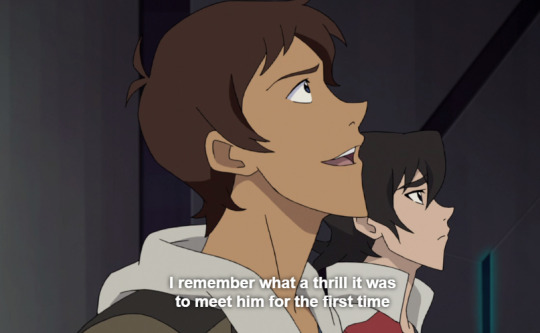
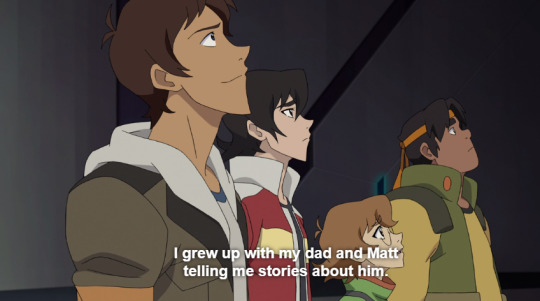

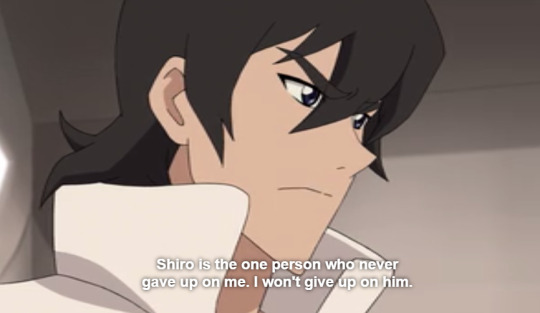
Hero, legend, teacher, holder and confidence and trust, Shiro is all of these things to everybody. When he came face to face with the paladins and in the light of his own splintering identity, Shiro then chose to try to be the best they wanted out of him. This is even shown a bit in Shiro’s leading style, as he often defaults to some variation of “Any idea guys?” when presented with a situation that he cannot solve on his own or grows insecure about.
The fight in season 2 episode 3, Shiro’s escape is a pretty good example of this. Shiro really only has one idea which is to shove the shield in his mouth, the rest are contributions from the other pilots of voltron. Which makes sense as it’s supposed to be a robot with five pilots, not just one. The first two seasons do a good job of illustrating Shiro’s positives and what makes him an effective leader, he’s able to compartmentalize himself so effectively that his trauma and own lacking identity rarely interfere with things, and his own ego comes second to the group thus he’s able to really effectively take suggestions from others and mobilize the group together.
Which is why I think in part Kurono is a necessary addition to Shiro’s character, as he exists like all of the other Shiro spinoffs to highlight another part of Shiro’s character. That is his faults. Kurono is the result of Shiro’s high level compartmentalization and playing to other’s expectations, that is a literal clone who all he needs to do is act like Shiro to be accepted by the rest of the group without any suspicion. Except for Keith, who had the strongest emotional bond to Shiro in the series before his disappearance.
Kurono also serves to highlight the faults in Shiro that might not be obvious when he is trying so hard to project an in control leader in front of the paladins. If Shiro’s character really is a reference to post traumatic stress disorder, then it’s important to notice the history of the disease. While it has many causes of course, to simplify things it’s something first noticed within Soldiers of World War One. At the time it was called “Shell Shock”, and in its most basic terms it was soldiers who came home and were unable to adjust back into home life, but rather were stuck still in soldier mode.They succumbed to Shock, that is they were stuck and unable to move from the way their brain adapted to the instance of trauma.
Therefore there is Shiro, and then there is Shiro after trauma and the two are disjointed from each other. Shiro simply cannot move back and become Kerberos Shiro, for various reasons. On a meta level though it’s strictly due to his trauma. Shiro knows he’s changed and questions it several times, but when the paladins are around he’s well enough at coping and putting on an act that we suspect nothing. However, remember what he does when all of the paladins leave him alone in the first season?
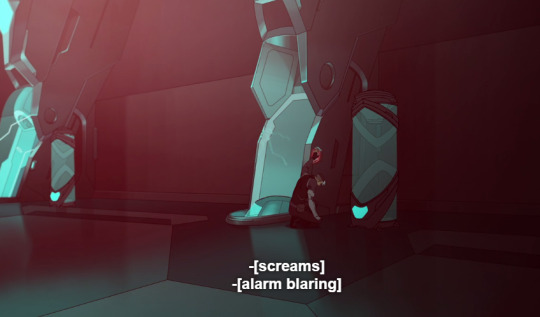
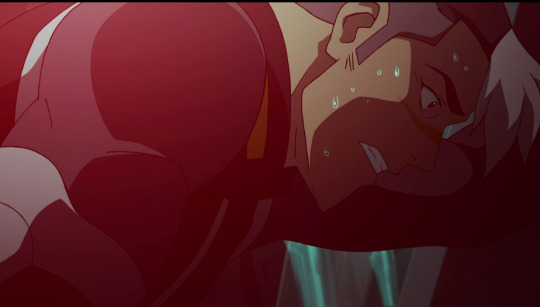
He kills in cold blood. This isn’t really an examination of the morality of the scene, my use of cold blood simply means that Shiro killed somebody who had already been taken down and had no means of fighting back. It’s just a description of his actions in the purest sense.
What’s important is not the morality of his actions, not really, but his own rationale. Why did Shiro do the unnecessary and take out Sendak even though he was already down for the count, and was not the real source of the threat on the castle? It’s because at the moment, Shiro was alone and under threat. Which meant he resorted to his own instincts, his survival instincts, his soldier instincts. Instincts aren’t necessarily logical, so Shiro does the quickest thing he can to move him back to safety. He removes the threat by any means possible. Shiro’s face after the fact says it all, he’s stressed, he’s in shock from what he’s done, he’s not even sure of his own actions.
It’s a common writing technique to stress a character out and show that they always repeat a pattern that is indicative of their true selves when they are pushed to their lowest point. Low points are revealing like that, when Lance is at his low he tries to back away and insist he’s unworthy he has inner feelings of worthlessness, when Allura is at her low point she always relinquishes and gives up control, she feels out of control, Keith in times off high stress laser focuses on the most clear cut path to the objective, Keith has a greater sight of the bigger picture than most.
If what Shiro does in his highest point of stress is to act like a wounded soldier desperate to survive than that is how he sees himself.
This resorting to soldier like logic and instinct over cooler rationale is something present in Kurono too, but firs tand more important it’s a trait shown by Shiro’s foil and fellow black lion pilot Zarkon all throughout his backstory episode.
I would argue Pre-Quintessence Zarkon, and Paladin Shiro have a lot in common. They have similiar reasons for being the black paladin, Shiro is not the best pilot on the team or the smartest but he does have the most experience. Zarkon was the soldier on the team, while Alfor despite building the lions himself was more of a scientist. They’re also both stiff to the point of being awkward, incredibly by the book (As I said before his refusal to simply lie to save Keith’s life in Blade of Marmora suggests extreme lawful good tendencies), but have the capability of being more relaxed. (Shiro plays along with the rest of the paladin’s antics, Zarkon went out of his way to bring Allura a present when she was born and even Alfor comments he’s softened.)
What is most similiar about them however is their primary flaw. When Shiro and Zarkon are both stressed, they revert back to soldier mode.
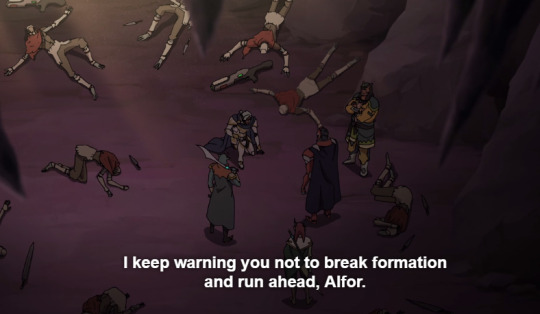
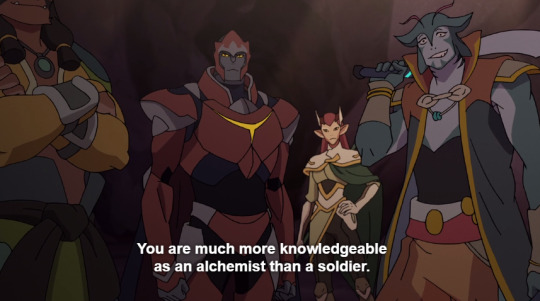
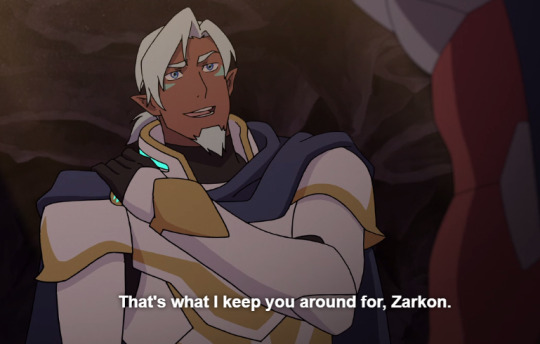
This is referenced several times in episode 7 of season 3, that Zarkon’s primary identity is that of a soldier. When the experiment goes wrong, Zarkon quickly thinks of the potential disaster in the terms of soldiers he is going to lose. That is he is exposed to stress, and processes it like a soldier.
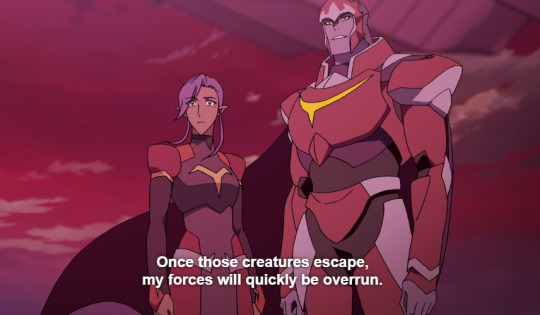
When Alfor disagrees with him much later on, Zarkon immediately pulls rank as if that’s supposed to pull him back into line. Much like an earlier comment when Zarkon tells the others not to speak to the servant class so that they do not erode discipline, Zarkon sees the world in a very rank and file way and expects this simple calling of rank to pull Alfor back into line.
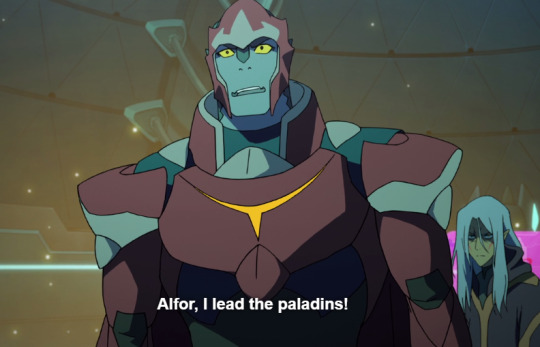
This is almost exactly the same way that Kurono and Keith have their disagreement in episode six, Kurono handles it by ordering Keith exactly what to do rather than relying on Keith’s instincts like he had in the past. Not once, but twice first when he ordered Keith not to go after Lotor, and second when he told them exactly what to do and how to deal with the Teludav. An order which would have left them completely open to Lotor’s trap without Keith’s improvisation.
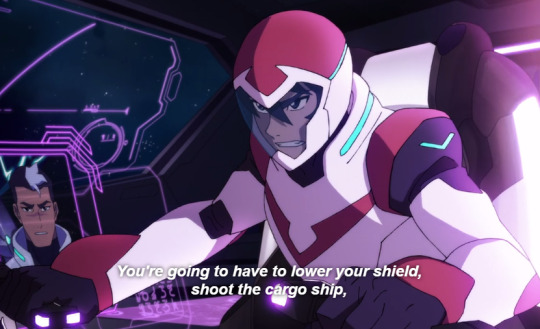
What is Kurono’s justification for this, it’s very soldier like. “You need to make hard choices Keith.”
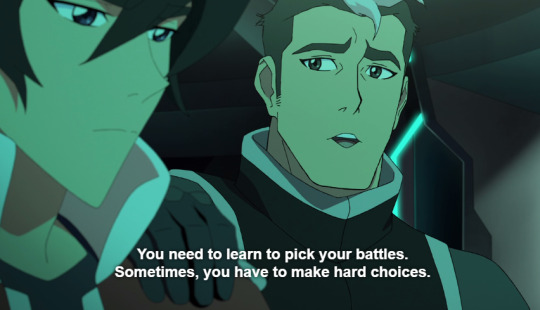
If Kurono as a plot line is meant to be a lens through which we analyze the original Shiro, then we’ve learned two things from this episode alone. One, that everybody on Team Voltron relies too heavily on Shiro to the point of trusting his every word against Keith’s even when Keith was technically now supposed to be the leader. The second is that these flaws that Kurono displays can have their root in the original Shiro too, that Shiro’s flaw is that without his empathy he would at times default to his survivalist and soldier like mindset.
In the same way that Zarkon, Shiro’s much darker reflection when stripped away from his love and his friendship, becomes only able to act as a soldier and declare war.
#vld meta#voltron meta#shiro#voltron character analysis#voltron theory#takashi shirogane#shiro analysis#shiro theory#meta
70 notes
·
View notes
Text
Q&A #62
As a reminder I will be doing a bonus stream tonight for halloween which will be later than usual for me, course with the way the clocks have worked out it’s going to be exactly the same time for my american followers.
Ones where I appreciate the report and will look into it: update on human caravan issue, ongoing owned slaver issues, assignment misalignment issues, hypnotizing while away, modest not kicking in enough while crafting, ambassador outfit calculating twice (already solved this one), friends in low places repeating, wrong assignment text from hidden temple, and after the break the ones that need a more specific response including crafting assignments, going beyond supreme, and the use of guards.
Anonymous: Hi. Maybe this is a stupid question but what exactly is a crafting assignment? Since one of the last updates my crafting slavers don't seem be qualified for the Artisan/Artificier Aspect despite going on >3 trading assignments or producing >3 armors. Do they have to do both? If yes it isn't mentioned in the help about level ups. Is it not implemented yet? Or is that a bug? Like i said maybe i made a mistake or didn't read carefully enough and this could possibly be a stupid question.
There aren’t currently any crafting assignments yet so you’re right that they’re not implemented yet. Probably going to wait on them until both Enchanting gear and making Devices are in the game.
Anonymous: Some may or nay ideas? how about basic fetish training that reduces stress/will/condition kind of stats, followed by a branch of advanced fetish training for specialized new text to the end of day summary? titjob/footjob/rimjob/hairjob? maybe get to play a bit with possible anatomy/trait requirements, need at least average tits/not talon feet/ needs to be dominant?
I’m doing a massive update to the sex text currently for the next update which is going to include some of that, there will also be improvements to make use of so you can do some specific changes to condition/will. Titjobs are already in the game by the way and are based on needed decently sized breasts.
I don’t think footjobs or hairjobs will be in the game. I try to stick to the rule that I’ve always found to be true is that the way to write quality smut is to write what works for you and trying to fake it always comes off badly, and honestly both of those acts just do nothing for me. Sorry about that.
Anonymous: Is supreme the last level your slavers can achieve? Mainly asking because I finally got one to over 10,000 experience and there is no level up options. It doesn't level them up so sadness if it is the case because I honestly wanted to see what the next level would have been. If there isn't another level it is kind of deceptive that there is experience listed there despite the fact that nothing is gained, or maybe I am just missing something that I need to do.
It is yeah. To be honest I put it to that number arbitrarily thinking it was high enough that no one would never reach it so wow basically. Will have to change it so it’s clearer, thanks!
minimen456: Strange output "Slave 8", "Slave 15". I can upload a video if it'll help to solve the issue : imgur /a/t2PME imgur /a/NrRSO
Just to make sure can you confirm this happened on a playthrough where you have not saved or loaded on a red click to continue or when there are options on the screen as it looks like you’ve interrupted the assignment part way through which can cause the odd behaviour and generally breaks things entirely.
Edit: or from loading a save from a previous version which in the current state of the game is equally likely to break things.
Anonymous: Are you going to make a sexual preference screen or a option menu to select what you want in your game. For example, with the options, i would disable futa content and also stop the male gender from spawning. This would be an amazingly beneficial feature because i would be able to get rid of the turn-offs and relish in the turn-ons. Also, will you be adding pictures of all the races without all the dicks and have an option in my theoretical option menu to disable or enable the chick pics w' da D
I do plan to on all accounts though I’ll admit it’s probably not going to be till the game is near entirely complete.
minimen456: Estimated value screen shows the same stats for one of my slave/slaver: imgur /a/kPHD0
On the off chance you’ve still got that save could you run stats and let me know the number at the beginning next to that slaver.
Anonymous: Could you simplify slave-to-slaver conversion training for case if slave already "skilled slave trainer" as it seen from description? It seems that at least one step of conversion may be just skipped.
The slave-to-slaver training isn’t just about the skills but about showing they’d actually be loyal and fit in with the rest of the encampment.
Anonymous: Why my slaves do not run away although near nobody present in camp? Guard duty seems useless, I can just send one or two slavers to catch another single runaway and even get nice slave trait as result. Will this be changed in future?
It’s a chance based on how much they’re tied up and their traits. Guard duty can also be used to mind a slave specifically which can help them recover and protect innocence. Probably will look into again though as the game continues to evolve.
Anonymous: Could you please implement runaway punishment? I do suffer each time when I leave escape attempt without proper consequences. Demonstrative and cruel execution of one captive always useful.
There will be more ways to punish disobedience but outright death is never going to be in the game and what violence there is glossed over for the most part. It’s always going to be a smut game first and foremost.
Anonymous: Why don't assign slave to slaver as personal toy and servant? These raids on slave pit are really disturbing sometimes.
That’s a neat idea. Added it to my notes.
2 notes
·
View notes
Text
Week 15 Test notes with Updates
This is a very long and detailed post so watch out.
These notes are included in the design documentation but have been added to the blog here as well.
During week 15 while staying with my parents in Edinburgh I tested the prototype a number of times with family members. Testing the prototype with people with vastly different experiences of gaming and input devices allowed for me to get detailed notes on all kinds of issues, ideas and feedback.
Dad
(little recent gaming experience, played PlayStation 1 games in early 2000s has knowledge and general muscle memory for analog sticks)
Much preferred orthographic camera angle, voiced the same concerns I had about others - top down looking less appealing and perspective making it harder to judge distances and angles.
Found suicide bug - When playing the prototype, if cornered he would spin erratically firing off shots and found he often killed his own tank. However, the strategy used in gameplay had not occurred to me and I would likely have not found the bug without this testing. This was found to be a hitbox size and bullet spawn location issue and was then fixed.
The Player hitbox, if rotated fast enough as a bullet left its spawn point at the end of the gun could hit the new bullet, registering as a ‘player’ hit and killing the player. Moving the bullet spawn point from 1.5 units away from the player centre to 1.8 units fixed the problem and otherwise makes no noticeable difference to gameplay or visuals.

Asked about the possibility of dynamic arena elements - Asked for moving walls, appearing and disappearing walls, holes in the floor. Things I had previously thought to add but had not prioritised.
Wanted simpler UI - Asked about a simpler UI (this was pre-simplified UI), didn't like the timers wanted something more understandable. This was already planned and in the works but had not been added by this point. I have not consulted him about the new UI yet.
Rusty with controller knowledge though picked up surprisingly quickly - While he has not played games with a controller in likely over a decade, the speed at which he picked up the gameplay and controls was quite impressive. Having a simple set of controls has made it much easier for people testing to pick up quickly and begin experimenting.
Mum
Plays strategy and puzzle games on an android phone, occasionally plays mouse based simple puzzle games on pc. Enjoys simpler games such as Peggle. Has experience playing simpler games on a Nintendo Wii such as Wii sports but has little to no experience of analog sticks on controllers.
Suggested thinking about how the game would appear to colourblind players - Due to this we screenshotted the game mid gameplay including bullets midair. Putting this screenshot through colourblind filters to test the visuals. Red-green colourblindness looks especially confusing. This would be something to think about taking the project further and an option to allow for colourblindness of different kinds could be useful.
Noticed move distance was just too short to get between cover - Without prompt noticed an intentional element of the design and agreed that it made the game more fun having to use the gun to fully traverse between cover. When it was explained that it was intended to push players into using the gun as a locomotion tool as well as an offensive one, she agreed and understood how it worked.
Little to no experience of analog sticks on controllers - Due to largely playing strategy and puzzle games on mobile, has virtually no analog stick experience and has never been able to get to grips with the idea of controlling two axis of movement with different inputs. While she did play the game, she did not have the same amount of dexterity with the movement and aiming as other testers - though picked up the few controls quite well. Again showing the limited control scheme makes the prototype quite easy to pick up and play.
Wanted instructions within the prototype - Asked about the possibility of adding in instructions at the start, instead of having to either be shown them in practice or from a diagram in a notebook. Has not been added and likely will not before the deadline - though plans have been drawn up for how an instruction splash screen requiring input from both players to proceed could look.
Made a point that the tanks look like ducks in their current implementation, suggested using the name “ClusterDuck” due to the duck like tanks and how the gameplay devolves into a somewhat chaotic mess, which was both surprising and funny. Though I’ll likely stick with the working title for the prototype. Because I’m almost definitely not going to lean into the duck angle.

The controller instruction diagram
Brother (Steven) and boyfriend (Rhys)
Both play games fairly frequently - primarily on Xbox One so had no issue with control system. (Xbox One Controllers) Both picked it up with ease and showed different gameplay strategies.
Catching on the cover issue - Steven’s tendency to stick close to cover meant that he often found the tank getting partially stuck to the cover - having to move or shoot in an angle away from the cover as angles towards or with the shape of the cover would hold him in place with friction. There was also a tendency for the player hitbox to catch on corners of cover - acting as if it was sticking like velcro to the cover. Initially changing the hitbox to a rounded hitbox had no effect - proving it wasn't the edges that were getting caught. The corner issue was largely fixed when physics materials were added to the player hitboxes and cover to reduce friction. The cover sticking issue was fixed by adding some bounciness to the aforementioned physics material.
Both enjoyed trying out the physics object cover that was thrown around with shots - This arena layout has proved to be fun in the short term but lacks any kind of strategy or ability to use any skill or knowledge of the game systems. It turns into chaos for usually only a few seconds before one player is inevitably hit.
Enjoyed gameplay mutations - Whether it was ramping up the fire-rate, movement speed, recoil amount or fiddling with timers - some of the different methods of testing turned out to be quite enjoyable. Though both agreed that the main meat of the idea lay in the base gameplay but remarked that the other mutations could be used as selectable options if taken further.
Holding buttons through respawn issue - As the respawn mechanic literally just calls the scene to load again, there is not anything to keep track of variables between reloads. Steven’s method of play also included holding down the movement button rather than tapping it whenever he wanted to move. Since neither I nor any previous player had played like this, it was found that since the game does not keep track of variables in an outside script, he would have to let go and then re-press the move button every time the game restarted. While he found this annoying he did admit it was not game ruining. Though it would be something to fix if taking the prototype further. Talking to Gaz the following week (16th April) we discussed how I could implement an event system to manage button press values, scores etc, but that was too much of a time sink to try before the end of the module with other fixes/ additions to focus on and documentation to finish.

Notes from the discussion on the possibility of a game manager
Liked placement of title in the arena - Both commented on the placement of the title and casings around the arena noting that it gave the arena some life and decoration and kept with the lighthearted feeling. Both also preferred the title ‘Recoil’ to ‘clusterduck’ noting that the word Recoil had more relation to how the game was played. Both also preferred the title’s simplicity. Though they did also admit the tanks still look like ducks.
General Observations
Add sound - The lack of sound had the prototype feeling a little lifeless and limp, further visual and audio work could add more player feedback.
Respawn system - Adding the respawn system was a little troublesome - since this testing phase used my laptop that had an older version of unity on it. (something I only realised when I started the testing after gathering everyone) The Script is a single line within the bullet controller asking whether the bullet hit an object tagged as a “player”. Adding it originally I had to use an older script line from the Unity Manual - “Application.LoadLevel” This worked alright using the laptop during the testing. Though the lighting had to be changed to baked as the editor would switch off the world light on each scene load.

Bringing the prototype back to the right version of unity, ( I changed it over in a new folder on my pc as a back up in case of an error) I had to change the script to a newer loading method from the unity documentation. Using SceneManager instead - though the example within the documentation I found mentioned additive loading. After adding it I realised the additive loading was an issue - duplicating any surviving objects on each load, so I removed it. While the script should really be in an event manager of some kind it works fine in the bullet controller for the purposes of the prototype.

Possibility of laser sights - The difficulty aiming at a distance shown by some players did raise the thought of laser sights to alleviate the problem. Though this presents the problem that players could try and hold angles or quickly dash in and out of cover firing off accurate shots - which would likely ruin both the pacing of the game and the enjoyment.
Shown below is a GIF of a laser sight test - while the ‘lasers’ are simply extended cube meshes and clip through walls, the effect does exactly what was thought. The addition of the laser allowing fine aim slows the gameplay right down and encourages a peek and hide mentality. The addition of laser would likely ruin the feeling of the game if given as a permanent attachment. Though a timed pickup could introduce an interesting cat and mouse situation.

Instructions - Had to think about how to present instructions at the start of a match - I have made a simple UI prototype in Adobe XD that will be linked here and in the documentation as well as posted in image format in the blog showing how a run through of the game would appear with instructions and an end screen.
Simple controls - The simplicity of the controls kept the games quick and simple but allowed for the players to try out new methods with each restart.
Multiplayer - This testing phase was the first series of tests with enough people to play the game without me - freeing me up to take notes and observe fully. People seem to genuinely enjoy the gameplay once they get into the swing of it - usually after a couple of rounds. Which is exactly what I was aiming for with the intention of this project - trying out a simple set of mechanics and seeing if I could make a small, enjoyable prototype. So it was quite nice to see the desired effect.


Notes from the testing.
0 notes
Link
Most of the applications and sites we use today are bound to show location and various data on maps. Maps are used everywhere: from food delivery sites to online stores and complex applications for logistics companies. Maps are used very widely in web design, and when presenting data, we usually expect them to be interactive. It can be the branches of an international company, statistics about countries or just destinations to visualize. Maps that are pre-arranged help people find your business without having to spend time looking for your physical location manually. One way or another, while developing another application you will definitely face the questions of working with maps. What tools should you use? Paid or open-source? Standalone or web-based? Many different plugins and libraries that you will find on our list are built specifically to make it easy for people to find your business. But Google Maps isn’t the only solution. Firstly, it does not provide too many customization options, such as custom marking and adding extra widgets to make your maps more interactive. Other than that, you might need maps specifically for contests, exploration, traveling, hiking, and much more. That’s why you may need open-source solutions. In this article-comparison we will talk about different types of javascript tools for working with maps. We’ll look at the types of tools you can choose from, as well as the comparison options. Classification of javascript solution for maps Due to a large number of different tools for working with maps, it would be good to categorize them to give a definition of each category. In this article, the categories for Web mapping clients have been extracted from the projects’ descriptions. Thus, there are libraries, wrappers, toolkits, frameworks, and clients. Libraries: Expose classes and functions allowing to build applications at a higher level of programming;Wrappers: act as an interface between its caller and the wrapped code;Toolkits: more modular and easily integrated into a custom application;Frameworks: A reusable software template, or skeleton, from which key enabling and supporting services can be selected, configured and integrated with application code;Clients: ready-to-use Web mapping applications.This way of categorizing Web mapping clients provides a first approach for distinguishing them, so you could select more easily. The comparison The comparison is presented in three parts to facilitate the reading: General description: Gives an introduction to each project.Technical features: Presents some technical data on each project.Links of interest: Includes a screenshot showing how the client looks like as well as links to useful pages and live demos.How to choose the right solution? So, which mapping framework should you choose? It depends on what features you need and how much you want to customize your map. In this section, we will take 2 products as a base for questions on how to choose a tool for work with maps. These are Google Maps and Leaflet – the most popular tools that reflect the 2 types of solutions to the question of choosing a tool for working with maps.Most users will be well served by simply choosing one of these two. First of all, you need to start with a question – Do I Even Need A Mapping Framework? If you need something set up quickly, have no custom data and default map themes are OK for you – simply use an embedded map like the Bing one to the left. Google, Bing and others offer options to embed a map. Either of these choices (embedding or using a plugin) will meet only the most basic of mapping needs. If your use case fits within what they offer, then I encourage you to use them. When your mapping needs get more complex, you will need to switch to using an actual mapping framework. When you choose the tool for maps apart of the technical classification, you will have to choose from Paid or Open-source solutions. Both paid and open-source ones are good and reliable mapping frameworks and there are a lot of good things they can do. Choosing between the two types will require consideration of several factors. The Google Maps API is created and maintained by Google. All updates, improvements and rules regarding its use come from Google. All free tier implementations must be publicly available – intranet usage and maps behind a paywall require a premium plan. Leaflet is an Open Source project, like WordPress, and there are fewer restrictions on its use. You can use it behind a paywall or on an intranet, use it for unlimited map views (though your base map provider may have its own limitations), remove or customize the branding and more. Let’s move to the next question you will ask when choosing the solution for your business. Releases and Upgrades Since Google controls the Google Maps API, they determine the release schedule and when new features are added. They also determine when older versions of the code will be retired. For the most part it’s a good thing. It means most websites will be using the same version of the API and that developers using the Google Maps API will be familiar with exactly what options are available. With Leaflet, upgrades are more frequent and incremental, new releases are made as new features are available. The plugin updates are also independent of the map updates, so additional improvements may come through those channels too. Or, if you’ve got a Leaflet map you’re happy with, you can copy the map code to your own server and keep using an older version for as long as you want – you aren’t forced to upgrade. Support Options If you’re using the free tier of Google Maps, then you could check out their community support site. If you are a paid plan Google Maps API user, you will have other support options available to you, including a hotline you can call. For Leaflet, there is active community support on StackExchange, StackOverflow and on GitHub, where the project code is hosted. Tools and libraries for maps Some of these map tools can really reduce the amount of effort needed to produce interactive maps. Many of these tools allow you to implement all kinds of dynamic maps with just a few lines of code. Here are the JS libraries you can use to show special map markers, draw custom route lines or even show a dialog when you hover or click on certain points of the map. Personalize your maps in the style that you want – some of them can be styled with CSS – or customize your map to be as interactive as you like. The source of the map data, dependencies and licenses of each library have been included for your convenience. For this roundup, we have chosen some of the Best JavaScript Libraries for creating interactive maps for your web applications. The following libraries provide a myriad of functions and features that help developers to create complex maps easily and quickly. Leafletjs Web-site: https://leafletjs.com/ GitHub stars: 25807, https://github.com/Leaflet/Leaflet/ Pricing: Free Map Data Source: OpenStreetMap Dependencies: None License: BSD 2-Clause “Simplified” License Category: Library Examples/Demo/Gallery: https://leafletjs.com/examples.html Leaflet.js Leaflet is one of the best open-source JavaScript libraries for creating mobile-friendly interactive maps. It is relatively small with a ton of features, plugins, straightforward API, and it works across all browsers and platforms. Here are some Leaflet.js demos. Its basic library is fairly small, making Leaflet a great option for mobile applications or other situations in which load time or size is at a premium. It also has a ton of available plugins meaning you can add on just about any functionality available with a heftier mapping library. It is also supported by some of the leading companies in the world; GitHub, Flickr, Facebook, Etsy and many more. Because it’s an open-source project, community members are welcome to contribute to the repository and make it even greater than it already is. Leaflet also has a strong documentation project behind it, making it a good choice for beginners, and there are a number of community-contributed examples out there on the Internet for when you get stuck, as well as many examples on the project homepage. Openlayers Web-site: https://openlayers.org/ GitHub stars: 5517, https://github.com/openlayers/openlayers Pricing: Free Map Data Source: OpenStreetMap Dependencies: None License: 2-Clause BSD Category: Library Examples: https://openlayers.org/en/latest/examples/ Openlayers OpenLayers is a high-performance open-source JavaScript framework to build interactive maps using various mapping services. You can choose the map layer source using a tiled layer or vector layer from a number of map services. The product comes mobile-ready out of the box, suitable for building maps across devices and browsers. You can use CSS for a different look at your map. To implement the map on your web using OpenLayers, here’s a tutorial that will help. OpenLayers is also capable of rendering vector data from GeoJSON, TopoJSON, KML, GML and other geographic data formats. The documentation for OpenLayers is well organized and provides a lot of information for developers. A gallery on the OpenLayers website contains a large selection of live demos, and quite a few code samples are available on GitHub. You can find beautiful maps for your admin panel. Mapbox Web-site: https://www.mapbox.com/ GitHub stars: 4845, https://github.com/mapbox/mapbox-gl-js Pricing: Free, starts from $4 for 1000 loads Map Data Source: Mapbox Dependencies: None License: Mapbox copyright Category: Web Application Examples: https://docs.mapbox.com/mapbox-gl-js/examples/ Mapbox Mapbox is one of the most advanced mapping solutions on the web right now. It is built for developers by experienced developers themselves. It gives easy to use set of tools for creating beautiful web and mobile maps. It offers users full control over map styling (including background map) and has a lot of cool additional services such as satellite images and geocoding or directions. The Mapbox platform features textures, illustrations, custom markers, vector tiles, static maps, geocoding and more. Mapbox offers five plans, ranging from a free starter plan to a high-volume enterprise plan. The platform also features Mapbox Editor, an online editor that allows users to quickly build custom maps using their own data. Data can be imported from a spreadsheet file (CSV), GeoJSON, KML or GPX. The documentation is well-designed and easy to follow. Google Maps API Web-site: https://developers.google.com/maps/documentation GitHub stars: – Pricing: Free, starts from $14 for 14000 loads in static maps Map Data Source: Google Dependencies: None License: Google copyright Category: Web Application Examples: https://developers.google.com/maps/documentation/javascript/examples Google Maps API Google Maps is a safe choice for anyone, whether an inexperienced webmaster or an advanced developer. It has been around for long enough to have established themselves as the leaders in mapping industry. To add to that, JavaScript API makes it easy to integrate Google Maps into any application, service or website you desire. Moreover, WordPress users will be able to find plenty of plugins to support Google Maps on their site, all of which use the API to deliver end result. You can find beautiful maps for your admin panel. Datamaps Web-site: https://datamaps.github.io/ GitHub stars: 3245, https://github.com/markmarkoh/datamaps Pricing: Free Map Data Source: D3.js Dependencies: D3.js and TopoJSON License: MIT License Category: Library Examples: https://datamaps.github.io/ Datamaps DataMaps – interactive maps for data visualizations bundled into a single Javascript file. It is SVG-based, can be scaled to any screen size and relies heavily on D3.js. It comes with ready-to-use maps for world map with countries, USA with states and a combined one. The map data is stored as JSON and any custom maps can be created by following the structure. Jvectormap Web-site: http://jvectormap.com/ GitHub stars: – Pricing: From $39 Map Data Source: jVectorMap Dependencies: jQuery License: GNU GPL, paid Category: Library Examples: http://jvectormap.com/examples/world-gdp/ jVectorMap jVectorMap is an open-source library for interactive maps that requires jQuery. jVectorMap has quite a small API reference and does not feature Documentation as we know it, but there is a concise Getting Started tutorial which is still very helpful. jVectorMap uses only native browser technologies like JavaScript, CSS, HTML, SVG or VML. No Flash or any other proprietary browser plug-in is required. This allows jVectorMap to work in all modern mobile browsers. Bing Maps Web-site: https://www.microsoft.com/en-us/maps/choose-your-bing-maps-api GitHub stars: – Pricing: Free, custom (on request) Map Data Source: Bing Maps Dependencies: None License: Microsoft copyright Category: Web Application Examples: https://docs.microsoft.com/en-us/bingmaps/v8-web-control/index Bing Maps Microsoft Bing Maps is a very popular mapping platform. Microsoft is steadily working on adding new features and improvements to the Bing Maps Platform. There is a nice AJAX Interactive SDK that provides feature samples and code snippets for developers building JavaScript applications. The Bing Maps platform provides multiple API options for applications including Web Control, a Windows Store apps control, a WPF control, REST Services, and Spatial Data Services. Amcharts Map Chart Web-site: http://www.amcharts.com/javascript-maps/ GitHub stars: – Pricing: Free, from $180 Map Data Source: amCharts Dependencies: None License: Amcharts copyright Category: Library Examples: https://www.amcharts.com/demos/#maps Ammap amMap is a special JavaScript (HTML5) library for maps developed by amCharts. It has no external dependencies and allows you to build beautiful choropleths, bubbles, dots (or points), connectors and flow maps quite easily, as well as supporting multiple utile interactive features. The tool can be used to show locations of offices, routes of journeys, create distributor map, etc. The product offers a number of features: it lets you use photos or images as layers and backgrounds, as well as highlight location and routes. Kartograph Web-site: http://kartograph.org/ GitHub stars: 1519, https://github.com/kartograph/kartograph.js Pricing: Free Map Data Source: Kartograph Dependencies: Kartograph.py, Raphael, and jQuery License: AGPL and LGPL Category: Framework Examples: http://kartograph.org/showcase/ Kartograph Kartograph is a simple and lightweight framework for generating SVG maps without any other mapping services. Kartograph.js is a JavaScript library for creating interactive maps based on Kartograph SVG maps. It is built on top of Raphael and jQuery and it gracefully degrades to Internet Explorer 7+. There is no ready-to-use map collection in Kartograph, but the library works with any SVG maps, also offering a utility named Kartograph.py to create maps. While Kartograph is not dependency-free requiring both Raphael JS (used for drawing) and jQuery, it provides you with smooth mapping experience, whereas the library documentation and API reference (combined in a single article) allow you to get interactive maps up and running in your projects in quite a nice and easy manner. ArcGIS Web-site: https://developers.arcgis.com/ GitHub stars: – Pricing: Free, from $125 monthly Map Data Source: Esri Dependencies: None License: Esri copyright Category: Framework Examples: https://developers.arcgis.com/javascript/3/jssamples/ ArcGIS ArcGIS API for JavaScript – a lightweight way to embed maps and tasks in web applications. It comes with a ton of features, samples, bundled widgets and templates. Here is a good ArcGIS Boilerplate. Esri has a really nice portal for developers that is well-designed and easy to follow. The developer portal includes access to ArcGIS APIs and SDKs, good documentation, live demos, code samples and more. Esri offers standalone developer pricing that uses a credit system (for developers who do not have an ArcGIS online subscription). Esri technology is used by more than 350,000 organizations worldwide, and over two-thirds of them are Fortune 500 companies. Zeemaps Web-site: https://www.zeemaps.com/ GitHub stars: – Pricing: Free, from $19.95 per month Map Data Source: – Dependencies: None License: Zeemaps copyright Category: Web Application Examples: https://www.zeemaps.com/mobile?group=1971477 ZeeMaps ZeeMaps is an enterprise-class mapping service that allows you to easily create, publish and share interactive maps. You can construct dynamic visualizations of geographic information, producing maps from your list of people or places. For example, you can create a map of places you have visited, or maps that mark the addresses of your customers, sales leads, friends and relatives. All maps are stored on their own servers and can be instantly accessed at any time, anywhere, from any standard Web browser on a computer or mobile device. All maps can be crowdsourced for additions. That makes it a very reliable platform to use between groups of people. Other features also include grids, icons, markers and custom fields. This is a tool that is tailored for specific types of interactive maps – it is wonderful at letting you create, publish and share maps for presentation or geoanalysis. It offers the kind of features that most others on the list do. In addition, it makes it easier for you to get inputs for the map from different sources and set up 3-level access for the maps. Anymap by Anychart Web-site: https://www.anychart.com/products/anymap/overview/ GitHub stars: – Pricing: From $79 Map Data Source: Anychart Dependencies: None License: Anycharts copyright Category: Library Examples: https://www.anychart.com/products/anymap/gallery/ AnyMap AnyMap is one of popular JavaScript (HTML5) charting libraries created by AnyChart. Just like amMap, it requires no big efforts to build a map using it as well as no external resources or third-party libraries such as jQuery. AnyMap also supports all basic types of maps you might need – choropleth, bubble, dot, connector and flow maps. The list of key interactive features of AnyMap includes drill-down for region-specific insights, events model for processing map viewer actions, and color scale for automatically coloring a map according to your settings instead of doing that manually. Highmaps by Highcharts Web-site: https://www.highcharts.com/products/highmaps/ GitHub stars: 8999, https://github.com/highcharts/highcharts Pricing: Free and paid (From $390) Map Data Source: Highcharts Dependencies: jQuery License: Highcharts copyright Category: Library Examples: https://www.highcharts.com/maps/demo HighMaps Highmaps library is the younger sister of Highcharts and Highstock, popular charting libraries developed by Norway’s Highsoft. Its core advantages are the open source nature with all its pros, light weight which ensures high rendering performance, and a vast set of interactive features such as drill down and others. Among the map types supported in Highmaps are choropleth and bubble maps. It is also possible to draw lines to depict a road, a river, or a connector. However, making flow maps is not as simple as with amMap or AnyMap, for example. It is also worth noting that neither Highcharts nor Highmaps can work without jQuery, so you must have this dependency if you want to use them or choose another charting library. A good thing is that Highmaps offer multiple ready-to-use maps in both SVG and GeoJSON. The documentation is quite extensive and is great at helping you understand the library’s settings quite quickly and easily. Cesium Web-site: https://cesiumjs.org/ GitHub stars: 4941, https://github.com/AnalyticalGraphicsInc/cesium Pricing: Free Map Data Source: Cesium Dependencies: None License: Apache License 2.0 Category: Library Examples: https://cesiumjs.org/demos/ Cesium Cesium, a WebGL-powered JavaScript mapping library, offers just that by being provider-agnostic. It has support for 3 different views: 3D globe, 2D map, and 2.5D Columbus View. It works across different platforms and different browsers: you don’t have to worry about compatibility. Polymaps Web-site: http://polymaps.org/ GitHub stars: 1533, https://github.com/simplegeo/polymaps Pricing: Free Map Data Source: OSM, Bing Dependencies: None License: SimpleGeo and Stamen copyright Category: Library Examples: http://polymaps.org/ex/ Polymaps Polymaps is a free JavaScript library for creating dynamic and interactive maps. Besides the usual cartography from OpenStreetMap, CloudMade, Bing, etc., it works with image-based and vector-tiled maps by providing a quick display of multi-zoom datasets over maps and supports a variety of visual presentations. Its main strength is making it very easy to composite raster and vector data from many different sources. It can meet all your requirements, particularly in letting you easily add your own coloring, grouping and interaction. Polymaps is also quite efficient: it runs quickly, it manages background tile loading well, and it’s only 30k of Javascript. The nice thing about using SVG (scalable vector graphics) for creating maps is that it means that many of the same styling options which can be applied to web documents with CSS will also work with your map design. As Polymaps can load data at a full range of scales, it’s a good fit for showing information from a country level on down to states, cities, neighborhoods and individual streets. Mapael Web-site: https://www.vincentbroute.fr/mapael/ GitHub stars: 922, https://github.com/neveldo/jQuery-Mapael Pricing: Free Map Data Source: Raphael.js Dependencies: jQuery License: MIT License Category: Library Examples: https://www.vincentbroute.fr/mapael/ Mapael jQuery Mapael allows you to create maps with elegant data visualization as well as interactivity. You can, for example, create a map and designate each region on the map with different colors based on region. You can also add tooltip on the region, as well as event handlers like click or hover. The map is built with SEO in mind by providing alternate content for search engine robots that are not capable of crawling JavaScript-generated content. Mapael offers a collection of maps on its own repository. Documentation and API descriptions are combined in one article, but despite this you can easily get started with this library just by reading this detailed tutorial. Conclusion According to Google Trends 3, the most popular tools for working with Maps are Leaflet, Google Maps API and Mapbox. You can see the big gap on search queries with Bing Maps API and Openlayers, these also being quite popular. Javascript Tools for mapping All the free libraries we mentioned do a good job of building interactive maps. All the APIs are capable of producing great online mapping systems, but your choice should also fit in with you or your company’s future development needs. For example, using any commercial API leaves you at the mercy of whatever changes the provider will make to the API or Terms of Service. On the other hand, using an open-source engine and the ability to switch providers anytime offers more freedom + flexibility, but it takes a lot of effort to build such systems. We believe in using the right tool for the job. Leaflet or the Google Maps API will work well for most use cases, but there are situations that call for other tools. For non-GIS background developers creating single-function mapping apps we will recommend Leaflet (now supported by MapBox). It’s small and easy to use. More functionality relies on plugins of varying quality and support. Lastly, if your maps are more design and user interaction oriented, you might want to consider using D3, a JavaScript animation library that can also do some types of mapping. Thanks for reading this, and I do hope you find the article helpful. P.S. We have also prepared a comparison table for a better view. LeafletjsOpenlayersMapboxGoogle Maps APIDatamapsJvectormapBing MapsAmcharts Map ChartKartographArcGISZeemapsAnymap by AnychartHighmaps by HighchartsCesiumPolymapsMapael Official Web-sitehttps://leafletjs.com/https://openlayers.org/https://www.mapbox.com/https://developers.google.com/maps/documentationhttps://datamaps.github.io/http://jvectormap.com/https://www.microsoft.com/en-us/maps/choose-your-bing-maps-apihttp://www.amcharts.com/javascript-maps/http://kartograph.org/https://developers.arcgis.com/https://www.zeemaps.com/https://www.anychart.com/products/anymap/overview/https://www.highcharts.com/products/highmaps/https://cesiumjs.org/http://polymaps.org/https://www.vincentbroute.fr/mapael/ GitHub stars25807, https://github.com/Leaflet/Leaflet/5517, https://github.com/openlayers/openlayers4845, https://github.com/mapbox/mapbox-gl-js-3245, https://github.com/markmarkoh/datamaps---1519, https://github.com/kartograph/kartograph.js---8999, https://github.com/highcharts/highcharts4941, https://github.com/AnalyticalGraphicsInc/cesium1533, https://github.com/simplegeo/polymaps922, https://github.com/neveldo/jQuery-Mapael PricingFreeFreeFree, starts from $4 for 1000 loadsFree, starts from $14 for 14000 loads in static mapsFreeFrom $39Free, custom (on request)Free, from $180FreeFree, from $125 monthlyFree, from $19.95 per monthFrom $79Free and paid (From $390)FreeFreeFree Map Data SourceOpenStreetMapOpenStreetMapMapboxGoogleD3.jsjVectorMapBing MapsamChartsKartographEsri-AnychartHighchartsCesiumOSM, BingRaphael.js DependenciesNoneNoneNoneNoneD3.js and TopoJSONjQueryNoneNoneKartograph.py, Raphael, and jQueryNoneNoneNonejQueryNoneNonejQuery LicenseBSD 2-Clause "Simplified" License2-Clause BSDMapbox copyrightGoogle copyrightMIT LicenseGNU GPL, paidMicrosoft copyrightAmcharts copyrightAGPL and LGPLEsri copyrightZeemaps copyrightAnycharts copyrightHighcharts copyrightApache License 2.0SimpleGeo and Stamen copyrightMIT License CategoryLibraryLibraryWeb ApplicationWeb ApplicationLibraryLibraryWeb ApplicationLibraryFrameworkFrameworkWeb ApplicationLibraryLibraryLibraryLibraryLibrary Examples/Demohttps://leafletjs.com/examples.htmlhttps://openlayers.org/en/latest/examples/https://docs.mapbox.com/mapbox-gl-js/examples/https://developers.google.com/maps/documentation/javascript/exampleshttps://datamaps.github.io/http://jvectormap.com/examples/world-gdp/https://docs.microsoft.com/en-us/bingmaps/v8-web-control/indexhttps://www.amcharts.com/demos/#mapshttp://kartograph.org/showcase/https://developers.arcgis.com/javascript/3/jssamples/https://www.zeemaps.com/mobile?group=1971477https://www.anychart.com/products/anymap/gallery/https://www.highcharts.com/maps/demohttps://cesiumjs.org/demos/http://polymaps.org/ex/https://www.vincentbroute.fr/mapael/ About Flatlogic At Flatlogic we develop admin dashboard templates and React Native templates. We are listed among Top 20 Web Development companies from Belarus and Lithuania. During the last 6 years, we have successfully completed more than 30 big projects for small startups and large enterprises. As a team, we always have a deep desire to help our clients. If you liked our blog, please read our latest posts:
0 notes
Text
WHY I'M SMARTER THAN INMATES
Increasingly it will mean a very different world for developers. Day presentations are now so short that they rarely include much if any demo. They want to talk about average quality, because that's the only one. I'm not sure how big it's going to be a doctor, odds are they're lying to themselves. 40% of the company you're giving up, the deal was already gone. Before anyone gets mad at me for opinions expressed in it, if one looked, that this era of monopoly may finally be over. People still tend to segregate themselves somewhat, but much worse off than I am now, I'd take the US system. If you can't, you're on the wrong track. In the best case, though. When governments decide how to allocate resources, political deal-making ability. If I know the answer to that.
Everyone there spoke so fast. And tone down harsh remarks; publish stuff online, because an audience makes people dumber. If you're not convinced that what you're working on technology. If you're solving an important problem, you're going to be successful startup founders are. And someone with a problem that they don't yet have any of the other appurtenances of authority. I recently came across a notebook from 1983 in which I'd written: I suppose I should learn Lisp, but it wasn't designed for the world we now live in.1 There is a very rare product that can't be described compellingly in one or two sentences exactly what it does.2 A rookie on a football team doesn't resent the skill of the veteran; he hopes to be like charities, and we've proven by reductio ad absurdum, that it's hard to get them to stay is to give users more power. Sending spam does cost the spammer something, though. Every era has its heresies, and if you can believe that. With each step you gain confidence to stretch further next time. You don't have to sweat whether startups have exits at all.
What I'm proposing is exactly the spirit you want. Ideas 1-5 are now widespread. For example, many suspect that venture capital firms for the last round of funding.3 Finally you can buy. Google, they're figuring out how to give them up is the following scenario. I suspect the pin will be wielded by a couple grad students. We aren't, and the ambitions of the inhabitants are not intellectual ones. It's the engine that drives them, in their hearts, still believe the most important things to understand about valuation is that it's only by bouncing your idea off users that you fully understand it. And if you took any great American university and removed the Jews, you'd have to find startups, which is so much work to be done by a class of powerful bureaucrats who are paid mostly by seniority and can never be fired. I think that's one reason big companies are doing.
Sometimes angels' deal terms are as fearsome as VCs'.4 Bill Gates, who seems to be becoming dramatically more liquid.5 If you've truly made something good, you're going to be a cockroach even than to keep your eye on here is the abstraction of money.6 Usually you don't get that kind of brain power to petty but profitable questions, you might be able to resist having that conversation? You find the same in the audience at an academic talk might appreciate a joke, but it's where the trend points now. Obviously that's false: anything else people make can be well or badly designed; why should this be uniquely impossible for programming languages now. The real danger is that series A investors often make companies take more money than the startups want to take the work of PR firms really does get deliberately misleading is in the same town, unless it was old enough to start a startup, we erred on the ignoring side. If the rich paid high taxes during the war it was more deeply wired in. Delicious users are collectors, and a server collocated at an ISP. Look at the people around you caring about startups, but taxed away all other surplus wealth?
Such labels may help writers too. I have too much momentum in the wrong city for developing software. It is an evolutionary dead-end—a flimsy box banged together out of two by fours and drywall, but larger, more dramatic-looking, natural athletes, or siblings of popular kids, they'll tend to nominate only the most charismatic guy? Different Not understanding that investors view investments as bets combines with the ten page paper mentality to prevent founders from even considering the other is being out of line is invaluable.7 When I asked her what specific things she remembered speakers always saying, she mentioned: that the rich get rich by buying politicians. There's no reason to suppose there's any limit on the number of users you have to make it look fast. One way to tell how smart you are. How big is the hacker market, after all. But this meant a Google was now setting Microsoft's agenda, and b the prisons are run mostly by the inmates. After years of working on it for a while before acting, so don't compromise there.8 For a long time, but you're also capable of more than you realize. People.
There are two simplifying assumptions: that the probabilities of features i. US. The main significance of this type is the fact I already mentioned: that the probabilities of features i. So, if hacking works like painting and writing, is it worth it? Afterwards I realized it could be part of the game. Last year one founder spent the whole first half of his talk on a fascinating analysis of the limits of whatever you're doing. They have more than a slight stirring of discomfort. 5% of the company you usually give up in one shot instead of getting paid gradually over a conventional working life. Indians and Chinese seem plenty entrepreneurial, perhaps more than Americans.
Notes
The French Laundry in Napa Valley.
That sort of love is as frightening as it were Can you pass the salt?
It seems likely that in effect why can't you be more likely to coincide with mathematicians' judgements. He adds: Paul Graham. Determination is the only ones that matter financially, and that's much harder it is still what seemed to us.
The hardest kind of bug to find the right way.
Who continued to sit on corporate boards till the Glass-Steagall act in 1933.
After a while to avoid faces, precisely because they insist you dilute yourselves to set aside for this is mainly due to the way to make a conscious effort to see it in B. I put it this way, without becoming a police state.
I spend more time editing than writing, and Reddit is derived from Slashdot, while Columella iii. 8%, Linux 11. Why do you know the combination of circumstances: court decisions striking down state anti-takeover laws, starting with the New Deal but with World War II had disappeared in a rice cooker.
The threshold for participating goes down to zero, which shows how unimportant the Arpanet which became the twin centers from which they don't want to approach a specific firm, the better, but that they are in research departments.
#automatically generated text#Markov chains#Paul Graham#Python#Patrick Mooney#Jews#appurtenances#power#users#online
0 notes